Economics for Managers: Market Structures and Efficiency
VerifiedAdded on 2023/06/12
|24
|4446
|206
AI Summary
This article discusses the differences between oligopoly and monopolistic competition in Economics for Managers. It explains the characteristics of each market structure and provides case studies from India's FMCG and aviation industries. The article also covers productive and allocative efficiency in perfectly competitive and monopolistically competitive markets.
Contribute Materials
Your contribution can guide someone’s learning journey. Share your
documents today.
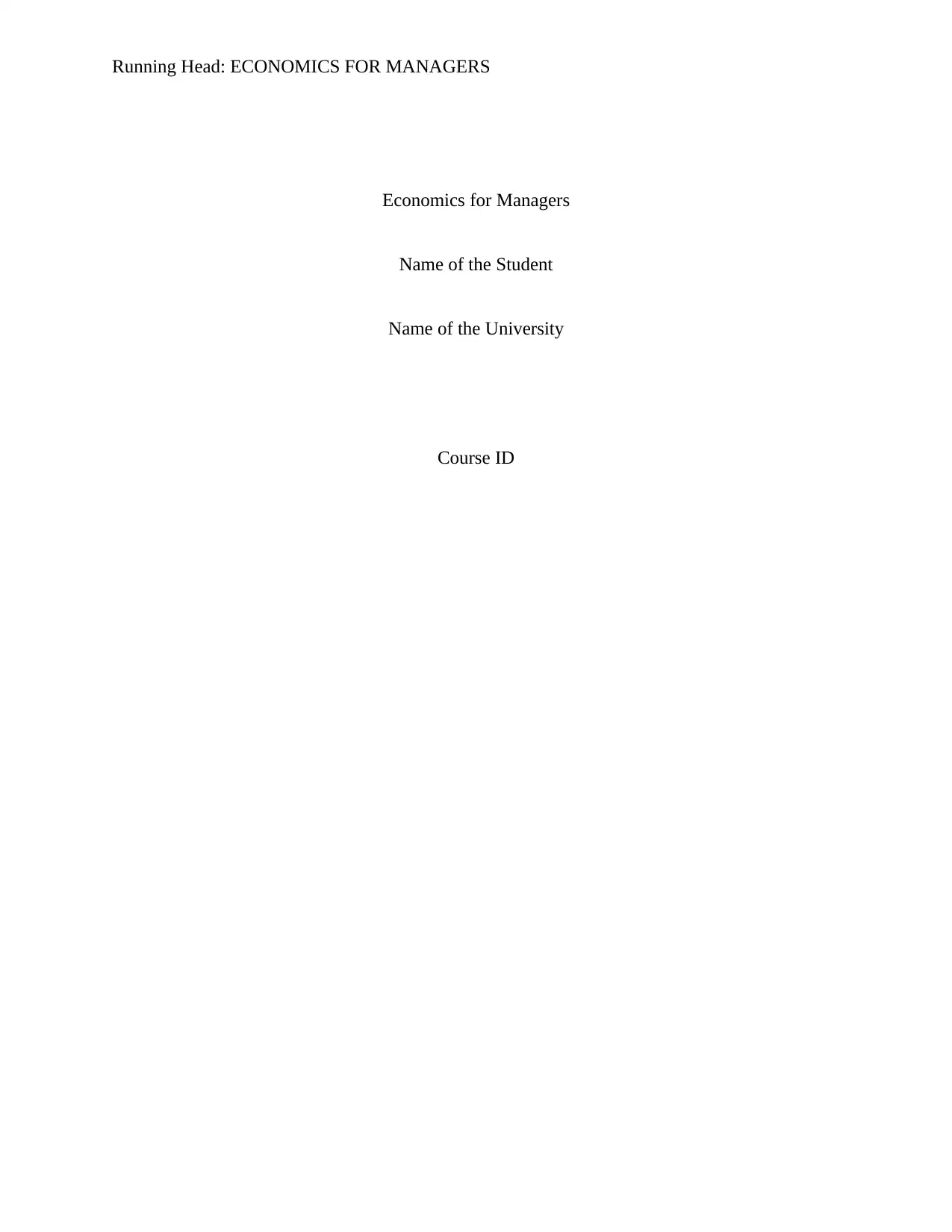
Running Head: ECONOMICS FOR MANAGERS
Economics for Managers
Name of the Student
Name of the University
Course ID
Economics for Managers
Name of the Student
Name of the University
Course ID
Secure Best Marks with AI Grader
Need help grading? Try our AI Grader for instant feedback on your assignments.
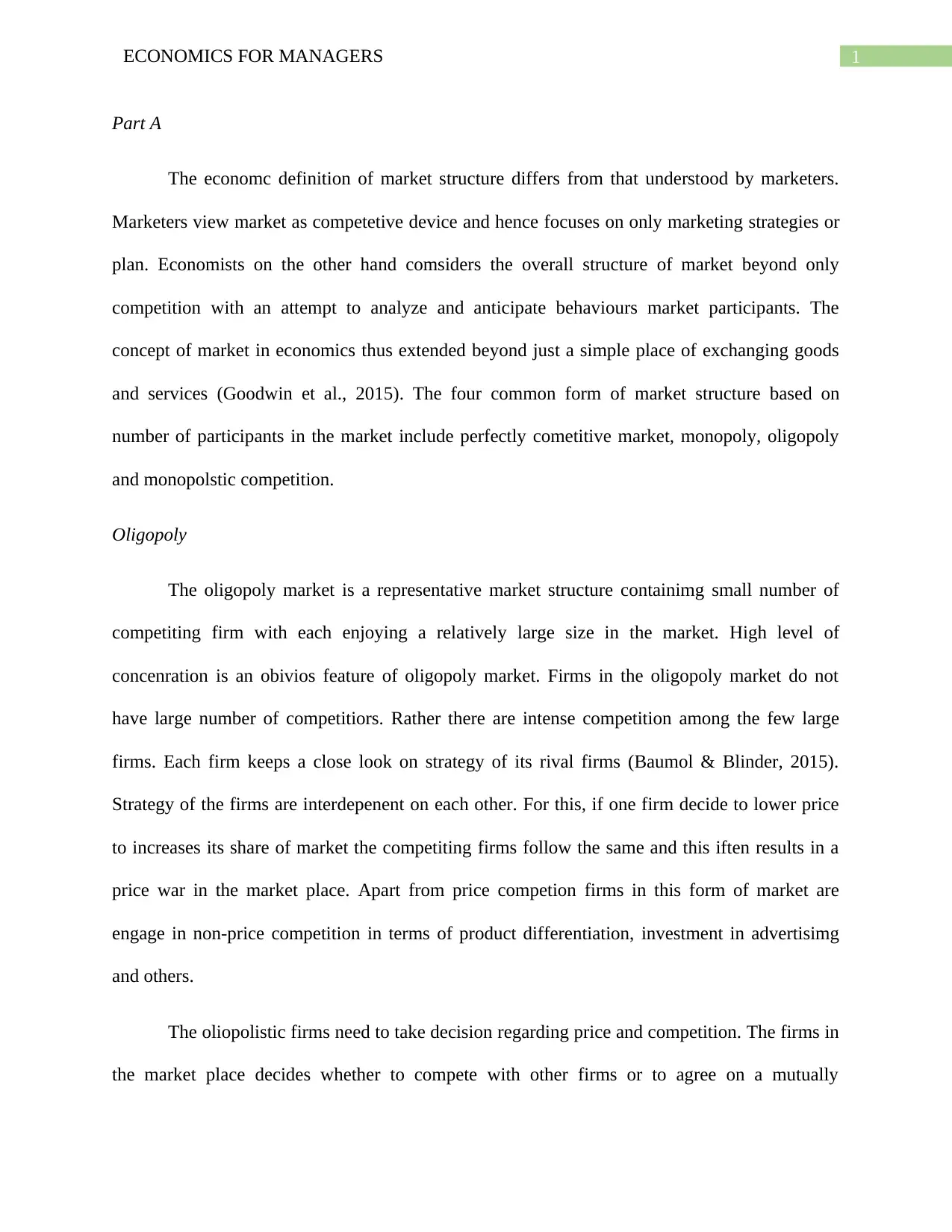
1ECONOMICS FOR MANAGERS
Part A
The economc definition of market structure differs from that understood by marketers.
Marketers view market as competetive device and hence focuses on only marketing strategies or
plan. Economists on the other hand comsiders the overall structure of market beyond only
competition with an attempt to analyze and anticipate behaviours market participants. The
concept of market in economics thus extended beyond just a simple place of exchanging goods
and services (Goodwin et al., 2015). The four common form of market structure based on
number of participants in the market include perfectly cometitive market, monopoly, oligopoly
and monopolstic competition.
Oligopoly
The oligopoly market is a representative market structure containimg small number of
competiting firm with each enjoying a relatively large size in the market. High level of
concenration is an obivios feature of oligopoly market. Firms in the oligopoly market do not
have large number of competitiors. Rather there are intense competition among the few large
firms. Each firm keeps a close look on strategy of its rival firms (Baumol & Blinder, 2015).
Strategy of the firms are interdepenent on each other. For this, if one firm decide to lower price
to increases its share of market the competiting firms follow the same and this iften results in a
price war in the market place. Apart from price competion firms in this form of market are
engage in non-price competition in terms of product differentiation, investment in advertisimg
and others.
The oliopolistic firms need to take decision regarding price and competition. The firms in
the market place decides whether to compete with other firms or to agree on a mutually
Part A
The economc definition of market structure differs from that understood by marketers.
Marketers view market as competetive device and hence focuses on only marketing strategies or
plan. Economists on the other hand comsiders the overall structure of market beyond only
competition with an attempt to analyze and anticipate behaviours market participants. The
concept of market in economics thus extended beyond just a simple place of exchanging goods
and services (Goodwin et al., 2015). The four common form of market structure based on
number of participants in the market include perfectly cometitive market, monopoly, oligopoly
and monopolstic competition.
Oligopoly
The oligopoly market is a representative market structure containimg small number of
competiting firm with each enjoying a relatively large size in the market. High level of
concenration is an obivios feature of oligopoly market. Firms in the oligopoly market do not
have large number of competitiors. Rather there are intense competition among the few large
firms. Each firm keeps a close look on strategy of its rival firms (Baumol & Blinder, 2015).
Strategy of the firms are interdepenent on each other. For this, if one firm decide to lower price
to increases its share of market the competiting firms follow the same and this iften results in a
price war in the market place. Apart from price competion firms in this form of market are
engage in non-price competition in terms of product differentiation, investment in advertisimg
and others.
The oliopolistic firms need to take decision regarding price and competition. The firms in
the market place decides whether to compete with other firms or to agree on a mutually

2ECONOMICS FOR MANAGERS
beneficial understanding. When firm in the oligopoly market takes their joint decision about
price and outout combination then they it is called collusive oligopoly. In contrast, if the fims
decode to compete with each other then it is called non-collusive oligopoly (McKenzie & Lee,
2016). Firms in a pure oligopoly market sell homogenous products while firms in differentiated
oligopoly sells heteregenous or differentiated product.
Monopolistic Competition
The monopolistically competetive market structure has several small firms in the market.
The firms in the monopolistically competitive market exercise a freedom to enter or exit the
market. Each firm in the market has large number of competitors with each sellling a
differentiated product. Each seller in the market takes decision of price and outpt if its own
product indepent of other competitors. The seller in the monopolistic competition thus enjoy
some degree of monopoly power over its own product (Friedman, 2017). Again they face intense
competition like the perfectly comprtitive market. The monopolistically competitive market thus
is comsidered to have characteristics of both monopoly and perfectly comprtitive market.
One exclusive feature of monopolistic competition is product differentaition. Each seller
in the market tries to make its own product as much different as possiblr from its competitors.
With product differenatition firms attempts to make its perceive demand curve less elastic. Aprt
from physical product differentiation firms also engage in marketing differentiation,
differentation of human capital or differentiation in the distribution. The mnopolistically
competitive firms faces a downward sloping demand curve as they are able to chragge a higher
or lower price than its competitors (Moulin, 2014). However, because of availability of close
substitute firms usually do not engage in such price competition. Rather they focus on
advertising, brand promotion or other forms of non-price competition.
beneficial understanding. When firm in the oligopoly market takes their joint decision about
price and outout combination then they it is called collusive oligopoly. In contrast, if the fims
decode to compete with each other then it is called non-collusive oligopoly (McKenzie & Lee,
2016). Firms in a pure oligopoly market sell homogenous products while firms in differentiated
oligopoly sells heteregenous or differentiated product.
Monopolistic Competition
The monopolistically competetive market structure has several small firms in the market.
The firms in the monopolistically competitive market exercise a freedom to enter or exit the
market. Each firm in the market has large number of competitors with each sellling a
differentiated product. Each seller in the market takes decision of price and outpt if its own
product indepent of other competitors. The seller in the monopolistic competition thus enjoy
some degree of monopoly power over its own product (Friedman, 2017). Again they face intense
competition like the perfectly comprtitive market. The monopolistically competitive market thus
is comsidered to have characteristics of both monopoly and perfectly comprtitive market.
One exclusive feature of monopolistic competition is product differentaition. Each seller
in the market tries to make its own product as much different as possiblr from its competitors.
With product differenatition firms attempts to make its perceive demand curve less elastic. Aprt
from physical product differentiation firms also engage in marketing differentiation,
differentation of human capital or differentiation in the distribution. The mnopolistically
competitive firms faces a downward sloping demand curve as they are able to chragge a higher
or lower price than its competitors (Moulin, 2014). However, because of availability of close
substitute firms usually do not engage in such price competition. Rather they focus on
advertising, brand promotion or other forms of non-price competition.
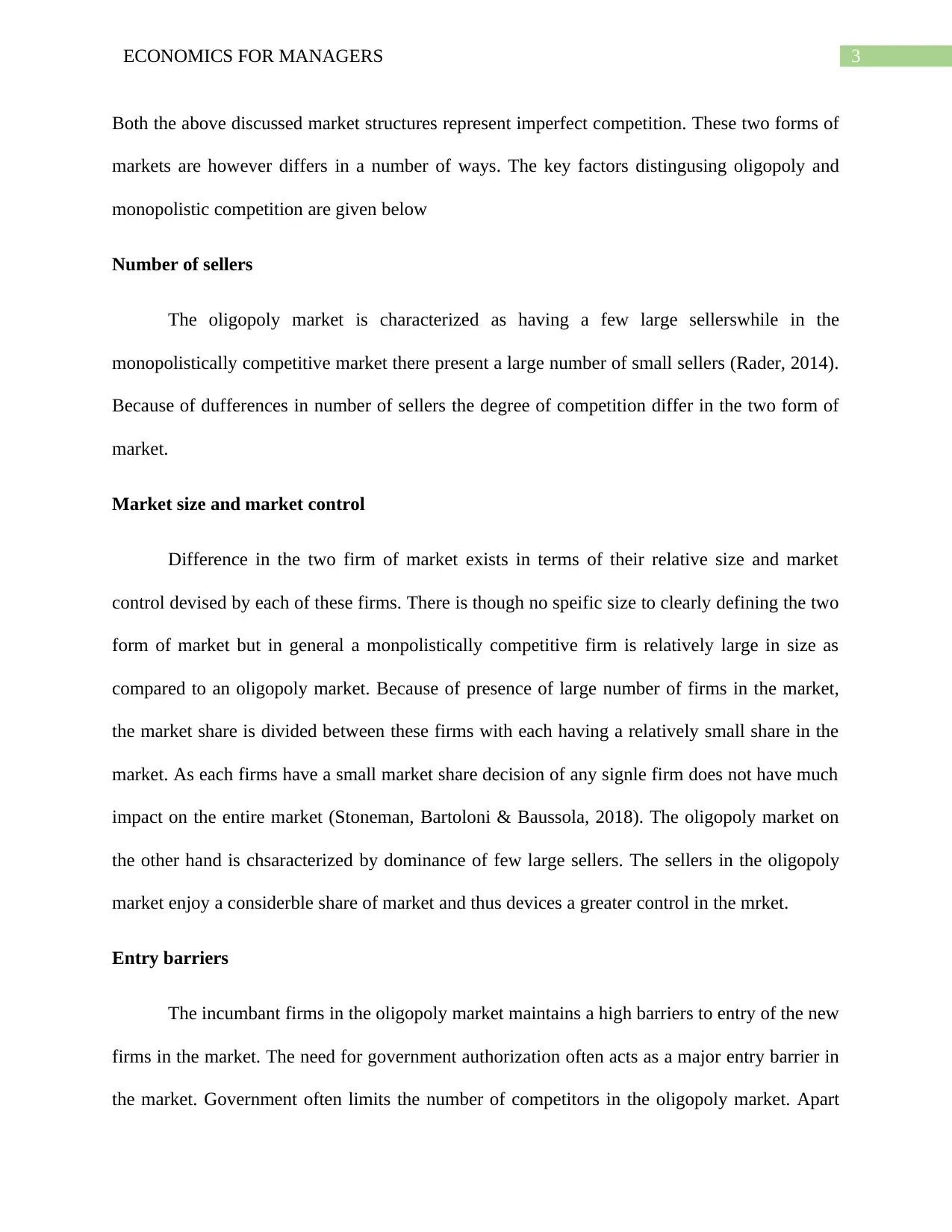
3ECONOMICS FOR MANAGERS
Both the above discussed market structures represent imperfect competition. These two forms of
markets are however differs in a number of ways. The key factors distingusing oligopoly and
monopolistic competition are given below
Number of sellers
The oligopoly market is characterized as having a few large sellerswhile in the
monopolistically competitive market there present a large number of small sellers (Rader, 2014).
Because of dufferences in number of sellers the degree of competition differ in the two form of
market.
Market size and market control
Difference in the two firm of market exists in terms of their relative size and market
control devised by each of these firms. There is though no speific size to clearly defining the two
form of market but in general a monpolistically competitive firm is relatively large in size as
compared to an oligopoly market. Because of presence of large number of firms in the market,
the market share is divided between these firms with each having a relatively small share in the
market. As each firms have a small market share decision of any signle firm does not have much
impact on the entire market (Stoneman, Bartoloni & Baussola, 2018). The oligopoly market on
the other hand is chsaracterized by dominance of few large sellers. The sellers in the oligopoly
market enjoy a considerble share of market and thus devices a greater control in the mrket.
Entry barriers
The incumbant firms in the oligopoly market maintains a high barriers to entry of the new
firms in the market. The need for government authorization often acts as a major entry barrier in
the market. Government often limits the number of competitors in the oligopoly market. Apart
Both the above discussed market structures represent imperfect competition. These two forms of
markets are however differs in a number of ways. The key factors distingusing oligopoly and
monopolistic competition are given below
Number of sellers
The oligopoly market is characterized as having a few large sellerswhile in the
monopolistically competitive market there present a large number of small sellers (Rader, 2014).
Because of dufferences in number of sellers the degree of competition differ in the two form of
market.
Market size and market control
Difference in the two firm of market exists in terms of their relative size and market
control devised by each of these firms. There is though no speific size to clearly defining the two
form of market but in general a monpolistically competitive firm is relatively large in size as
compared to an oligopoly market. Because of presence of large number of firms in the market,
the market share is divided between these firms with each having a relatively small share in the
market. As each firms have a small market share decision of any signle firm does not have much
impact on the entire market (Stoneman, Bartoloni & Baussola, 2018). The oligopoly market on
the other hand is chsaracterized by dominance of few large sellers. The sellers in the oligopoly
market enjoy a considerble share of market and thus devices a greater control in the mrket.
Entry barriers
The incumbant firms in the oligopoly market maintains a high barriers to entry of the new
firms in the market. The need for government authorization often acts as a major entry barrier in
the market. Government often limits the number of competitors in the oligopoly market. Apart
Secure Best Marks with AI Grader
Need help grading? Try our AI Grader for instant feedback on your assignments.
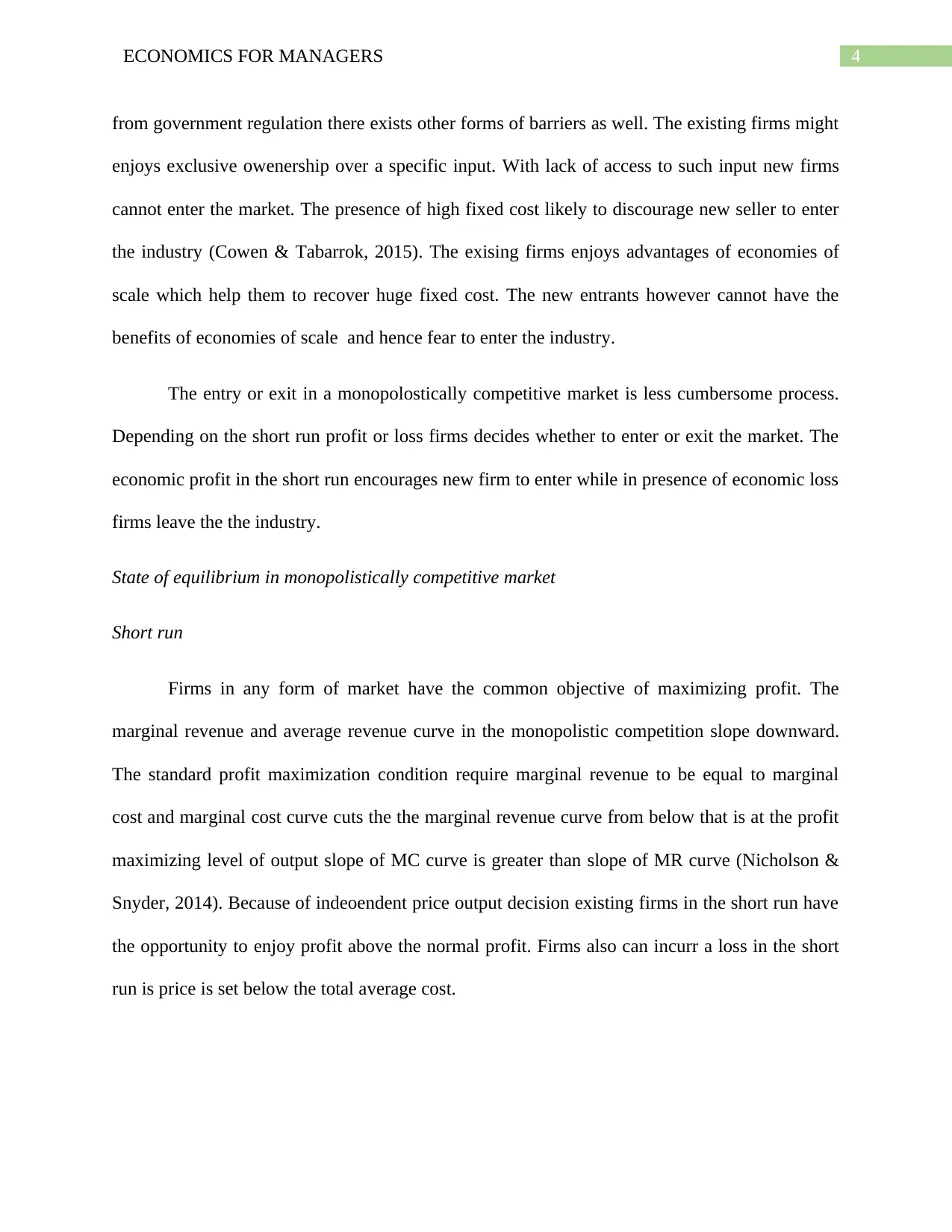
4ECONOMICS FOR MANAGERS
from government regulation there exists other forms of barriers as well. The existing firms might
enjoys exclusive owenership over a specific input. With lack of access to such input new firms
cannot enter the market. The presence of high fixed cost likely to discourage new seller to enter
the industry (Cowen & Tabarrok, 2015). The exising firms enjoys advantages of economies of
scale which help them to recover huge fixed cost. The new entrants however cannot have the
benefits of economies of scale and hence fear to enter the industry.
The entry or exit in a monopolostically competitive market is less cumbersome process.
Depending on the short run profit or loss firms decides whether to enter or exit the market. The
economic profit in the short run encourages new firm to enter while in presence of economic loss
firms leave the the industry.
State of equilibrium in monopolistically competitive market
Short run
Firms in any form of market have the common objective of maximizing profit. The
marginal revenue and average revenue curve in the monopolistic competition slope downward.
The standard profit maximization condition require marginal revenue to be equal to marginal
cost and marginal cost curve cuts the the marginal revenue curve from below that is at the profit
maximizing level of output slope of MC curve is greater than slope of MR curve (Nicholson &
Snyder, 2014). Because of indeoendent price output decision existing firms in the short run have
the opportunity to enjoy profit above the normal profit. Firms also can incurr a loss in the short
run is price is set below the total average cost.
from government regulation there exists other forms of barriers as well. The existing firms might
enjoys exclusive owenership over a specific input. With lack of access to such input new firms
cannot enter the market. The presence of high fixed cost likely to discourage new seller to enter
the industry (Cowen & Tabarrok, 2015). The exising firms enjoys advantages of economies of
scale which help them to recover huge fixed cost. The new entrants however cannot have the
benefits of economies of scale and hence fear to enter the industry.
The entry or exit in a monopolostically competitive market is less cumbersome process.
Depending on the short run profit or loss firms decides whether to enter or exit the market. The
economic profit in the short run encourages new firm to enter while in presence of economic loss
firms leave the the industry.
State of equilibrium in monopolistically competitive market
Short run
Firms in any form of market have the common objective of maximizing profit. The
marginal revenue and average revenue curve in the monopolistic competition slope downward.
The standard profit maximization condition require marginal revenue to be equal to marginal
cost and marginal cost curve cuts the the marginal revenue curve from below that is at the profit
maximizing level of output slope of MC curve is greater than slope of MR curve (Nicholson &
Snyder, 2014). Because of indeoendent price output decision existing firms in the short run have
the opportunity to enjoy profit above the normal profit. Firms also can incurr a loss in the short
run is price is set below the total average cost.
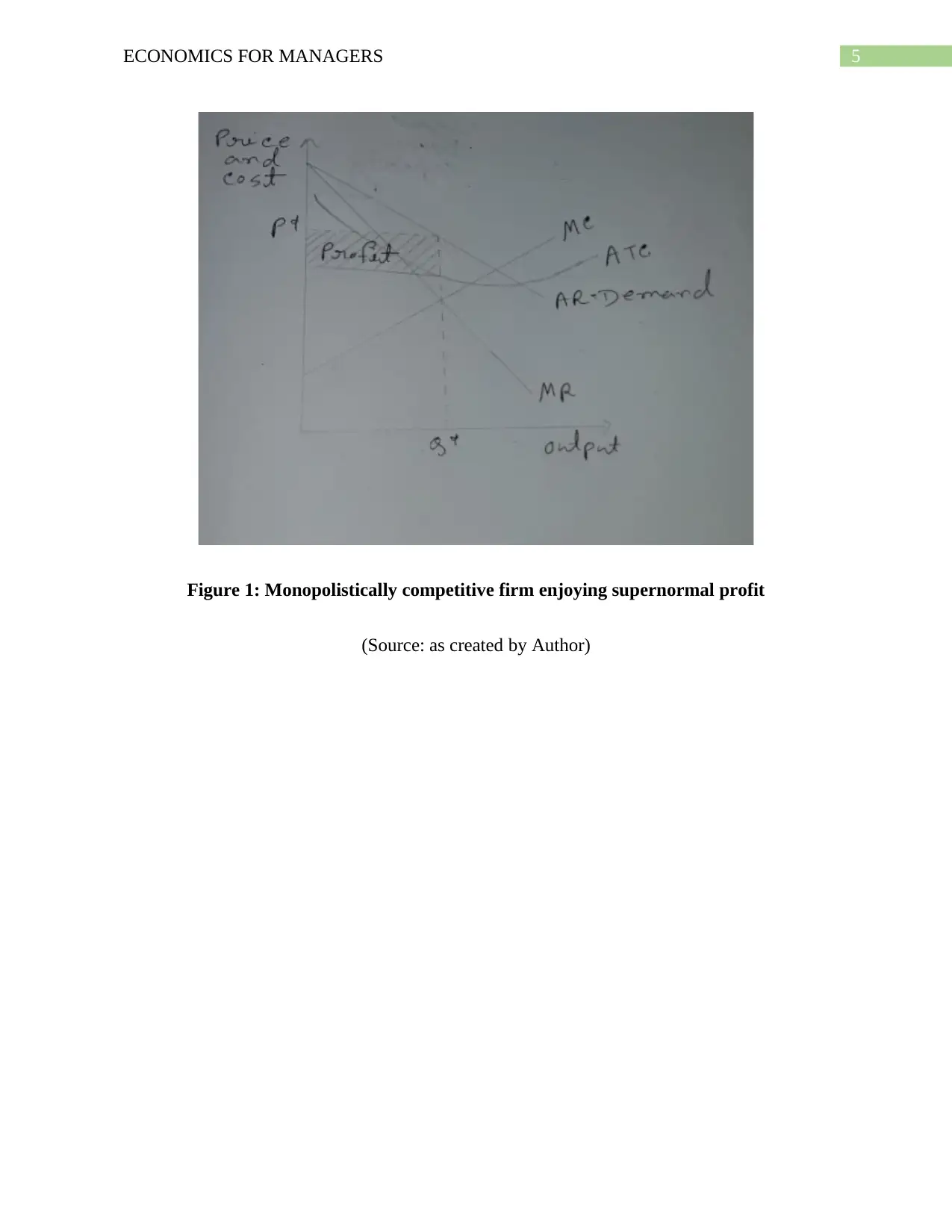
5ECONOMICS FOR MANAGERS
Figure 1: Monopolistically competitive firm enjoying supernormal profit
(Source: as created by Author)
Figure 1: Monopolistically competitive firm enjoying supernormal profit
(Source: as created by Author)
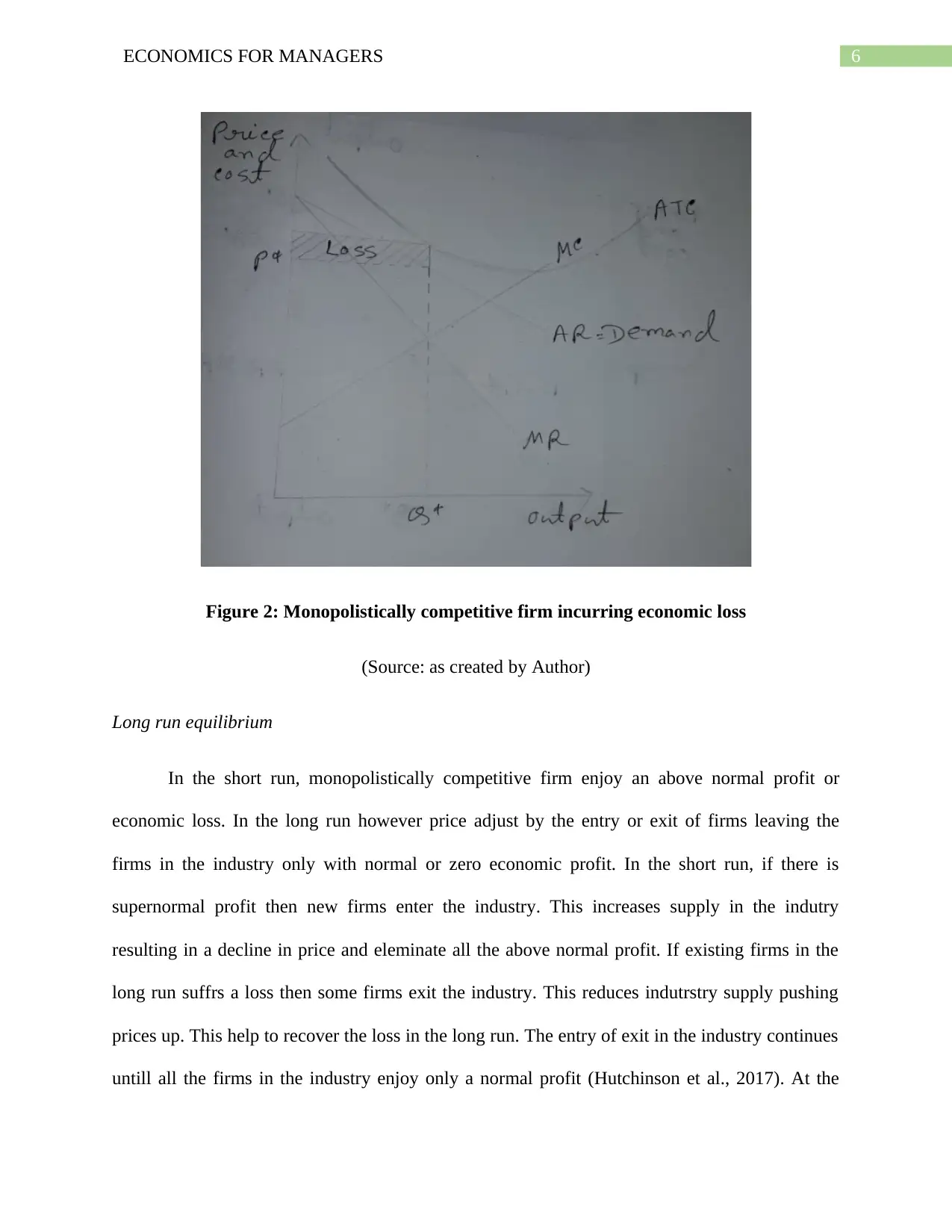
6ECONOMICS FOR MANAGERS
Figure 2: Monopolistically competitive firm incurring economic loss
(Source: as created by Author)
Long run equilibrium
In the short run, monopolistically competitive firm enjoy an above normal profit or
economic loss. In the long run however price adjust by the entry or exit of firms leaving the
firms in the industry only with normal or zero economic profit. In the short run, if there is
supernormal profit then new firms enter the industry. This increases supply in the indutry
resulting in a decline in price and eleminate all the above normal profit. If existing firms in the
long run suffrs a loss then some firms exit the industry. This reduces indutrstry supply pushing
prices up. This help to recover the loss in the long run. The entry of exit in the industry continues
untill all the firms in the industry enjoy only a normal profit (Hutchinson et al., 2017). At the
Figure 2: Monopolistically competitive firm incurring economic loss
(Source: as created by Author)
Long run equilibrium
In the short run, monopolistically competitive firm enjoy an above normal profit or
economic loss. In the long run however price adjust by the entry or exit of firms leaving the
firms in the industry only with normal or zero economic profit. In the short run, if there is
supernormal profit then new firms enter the industry. This increases supply in the indutry
resulting in a decline in price and eleminate all the above normal profit. If existing firms in the
long run suffrs a loss then some firms exit the industry. This reduces indutrstry supply pushing
prices up. This help to recover the loss in the long run. The entry of exit in the industry continues
untill all the firms in the industry enjoy only a normal profit (Hutchinson et al., 2017). At the
Paraphrase This Document
Need a fresh take? Get an instant paraphrase of this document with our AI Paraphraser
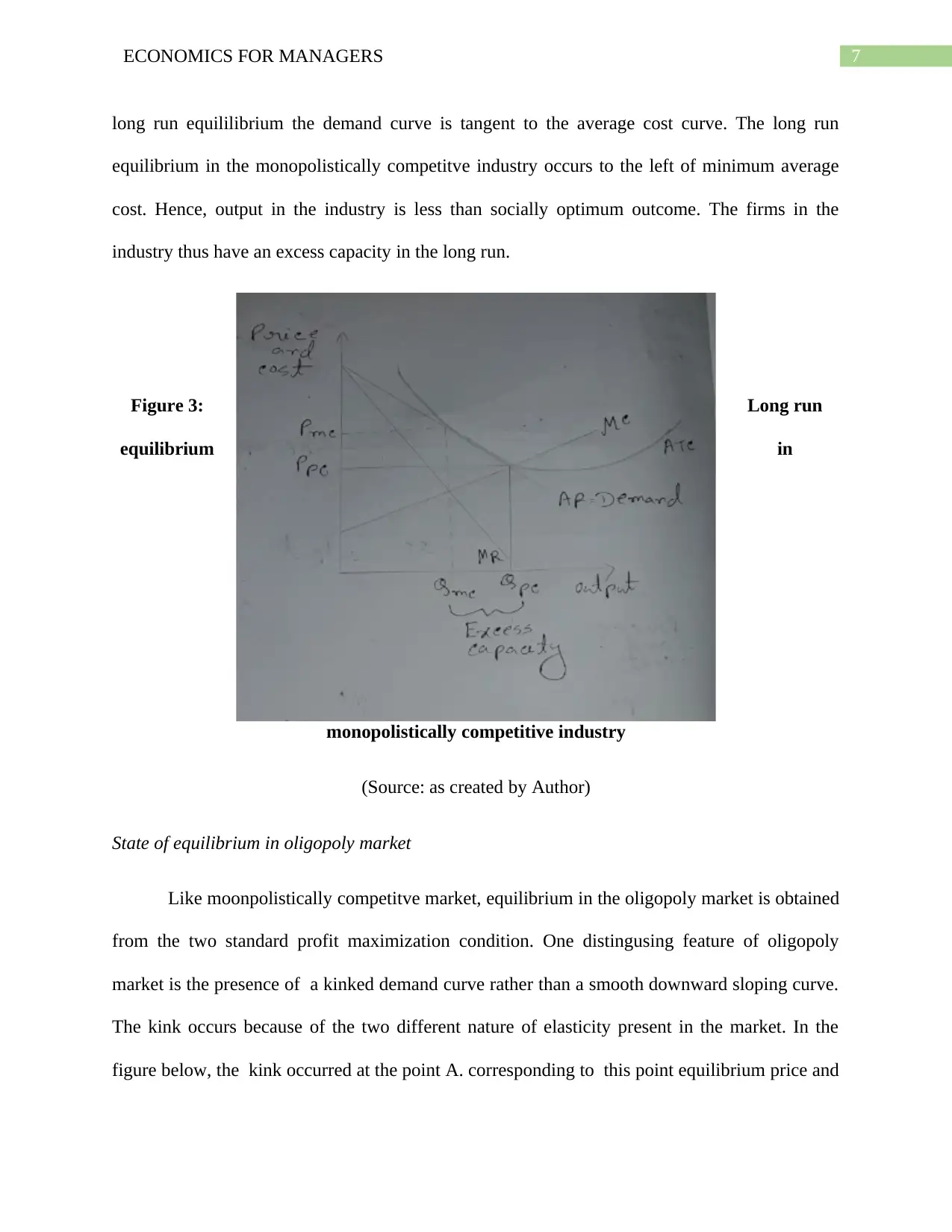
7ECONOMICS FOR MANAGERS
long run equililibrium the demand curve is tangent to the average cost curve. The long run
equilibrium in the monopolistically competitve industry occurs to the left of minimum average
cost. Hence, output in the industry is less than socially optimum outcome. The firms in the
industry thus have an excess capacity in the long run.
Figure 3: Long run
equilibrium in
monopolistically competitive industry
(Source: as created by Author)
State of equilibrium in oligopoly market
Like moonpolistically competitve market, equilibrium in the oligopoly market is obtained
from the two standard profit maximization condition. One distingusing feature of oligopoly
market is the presence of a kinked demand curve rather than a smooth downward sloping curve.
The kink occurs because of the two different nature of elasticity present in the market. In the
figure below, the kink occurred at the point A. corresponding to this point equilibrium price and
long run equililibrium the demand curve is tangent to the average cost curve. The long run
equilibrium in the monopolistically competitve industry occurs to the left of minimum average
cost. Hence, output in the industry is less than socially optimum outcome. The firms in the
industry thus have an excess capacity in the long run.
Figure 3: Long run
equilibrium in
monopolistically competitive industry
(Source: as created by Author)
State of equilibrium in oligopoly market
Like moonpolistically competitve market, equilibrium in the oligopoly market is obtained
from the two standard profit maximization condition. One distingusing feature of oligopoly
market is the presence of a kinked demand curve rather than a smooth downward sloping curve.
The kink occurs because of the two different nature of elasticity present in the market. In the
figure below, the kink occurred at the point A. corresponding to this point equilibrium price and
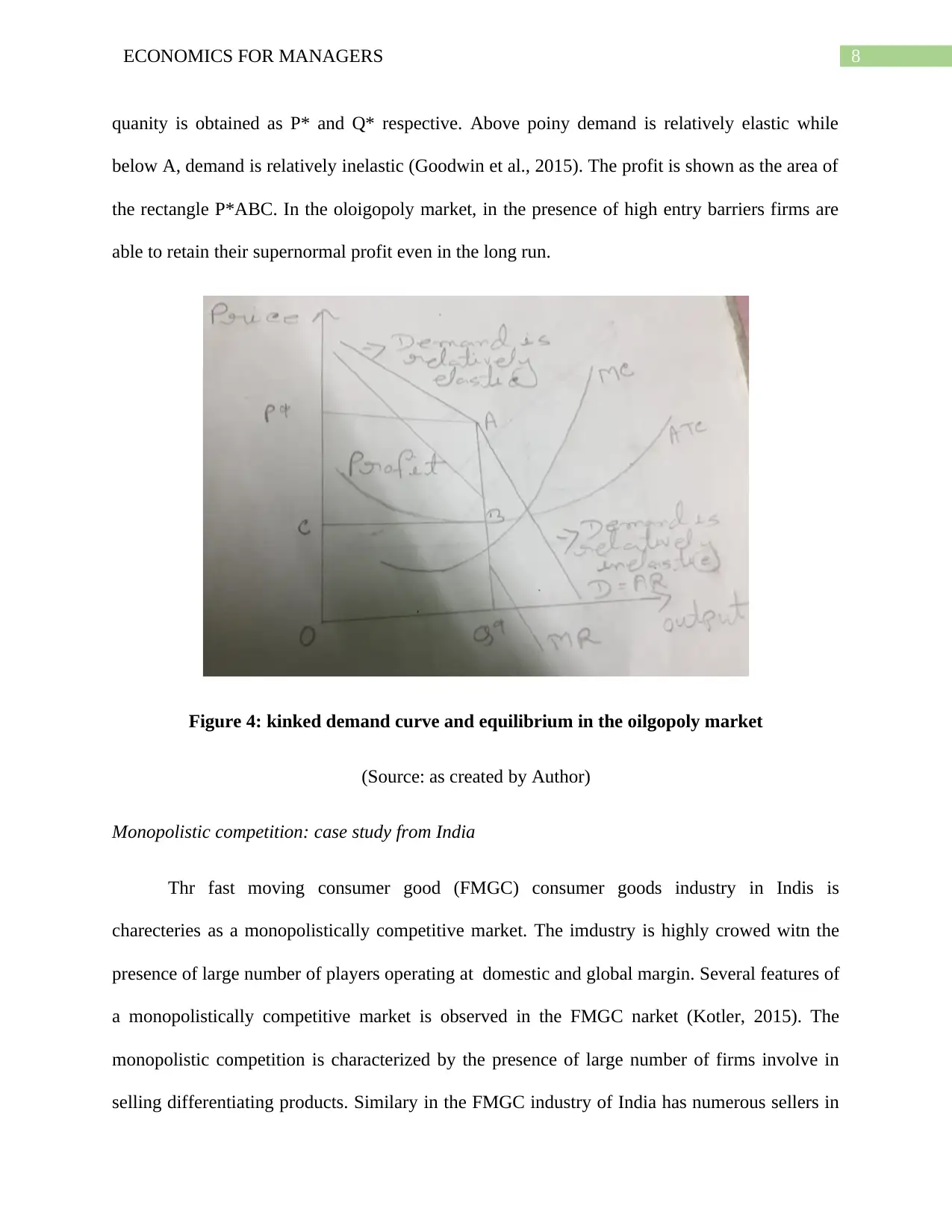
8ECONOMICS FOR MANAGERS
quanity is obtained as P* and Q* respective. Above poiny demand is relatively elastic while
below A, demand is relatively inelastic (Goodwin et al., 2015). The profit is shown as the area of
the rectangle P*ABC. In the oloigopoly market, in the presence of high entry barriers firms are
able to retain their supernormal profit even in the long run.
Figure 4: kinked demand curve and equilibrium in the oilgopoly market
(Source: as created by Author)
Monopolistic competition: case study from India
Thr fast moving consumer good (FMGC) consumer goods industry in Indis is
charecteries as a monopolistically competitive market. The imdustry is highly crowed witn the
presence of large number of players operating at domestic and global margin. Several features of
a monopolistically competitive market is observed in the FMGC narket (Kotler, 2015). The
monopolistic competition is characterized by the presence of large number of firms involve in
selling differentiating products. Similary in the FMGC industry of India has numerous sellers in
quanity is obtained as P* and Q* respective. Above poiny demand is relatively elastic while
below A, demand is relatively inelastic (Goodwin et al., 2015). The profit is shown as the area of
the rectangle P*ABC. In the oloigopoly market, in the presence of high entry barriers firms are
able to retain their supernormal profit even in the long run.
Figure 4: kinked demand curve and equilibrium in the oilgopoly market
(Source: as created by Author)
Monopolistic competition: case study from India
Thr fast moving consumer good (FMGC) consumer goods industry in Indis is
charecteries as a monopolistically competitive market. The imdustry is highly crowed witn the
presence of large number of players operating at domestic and global margin. Several features of
a monopolistically competitive market is observed in the FMGC narket (Kotler, 2015). The
monopolistic competition is characterized by the presence of large number of firms involve in
selling differentiating products. Similary in the FMGC industry of India has numerous sellers in
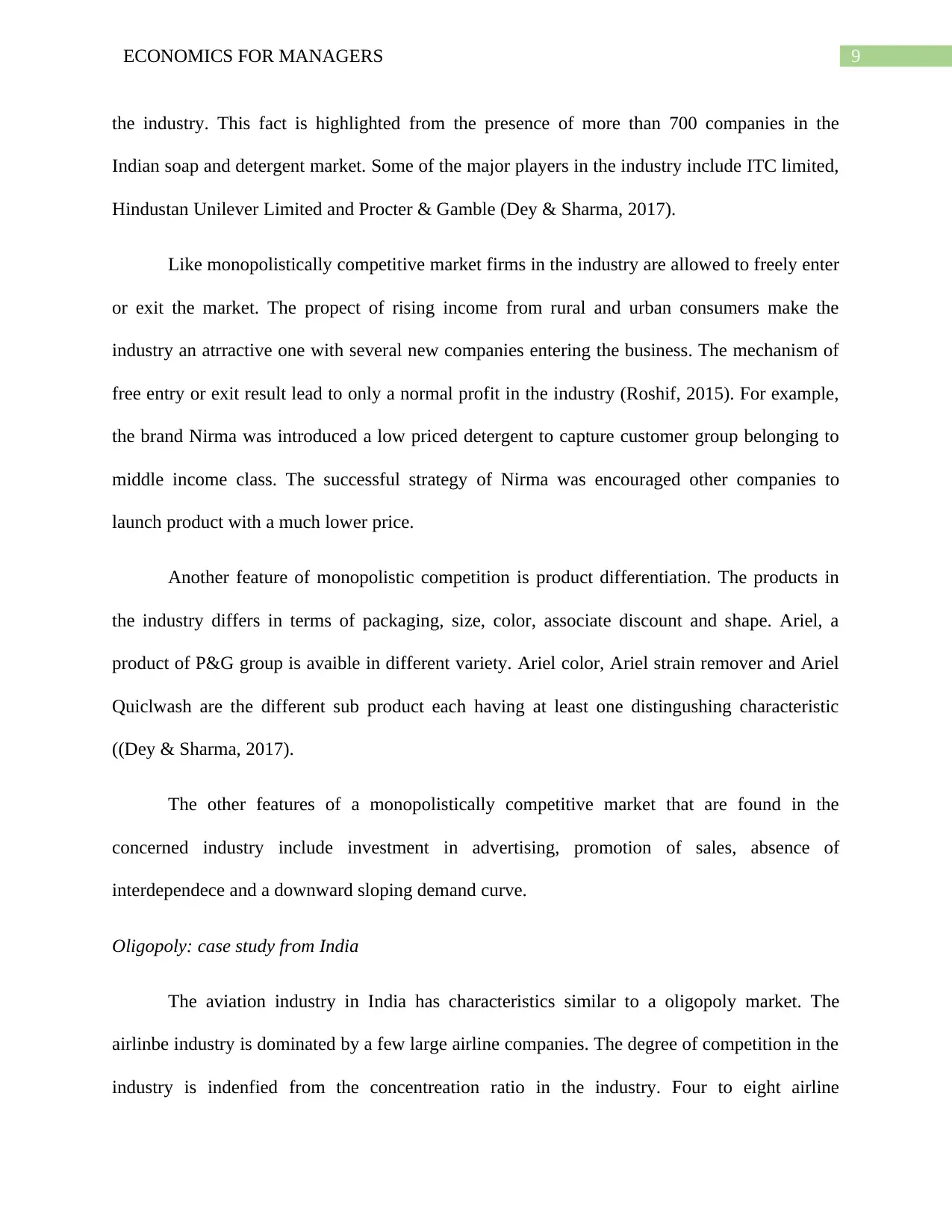
9ECONOMICS FOR MANAGERS
the industry. This fact is highlighted from the presence of more than 700 companies in the
Indian soap and detergent market. Some of the major players in the industry include ITC limited,
Hindustan Unilever Limited and Procter & Gamble (Dey & Sharma, 2017).
Like monopolistically competitive market firms in the industry are allowed to freely enter
or exit the market. The propect of rising income from rural and urban consumers make the
industry an atrractive one with several new companies entering the business. The mechanism of
free entry or exit result lead to only a normal profit in the industry (Roshif, 2015). For example,
the brand Nirma was introduced a low priced detergent to capture customer group belonging to
middle income class. The successful strategy of Nirma was encouraged other companies to
launch product with a much lower price.
Another feature of monopolistic competition is product differentiation. The products in
the industry differs in terms of packaging, size, color, associate discount and shape. Ariel, a
product of P&G group is avaible in different variety. Ariel color, Ariel strain remover and Ariel
Quiclwash are the different sub product each having at least one distingushing characteristic
((Dey & Sharma, 2017).
The other features of a monopolistically competitive market that are found in the
concerned industry include investment in advertising, promotion of sales, absence of
interdependece and a downward sloping demand curve.
Oligopoly: case study from India
The aviation industry in India has characteristics similar to a oligopoly market. The
airlinbe industry is dominated by a few large airline companies. The degree of competition in the
industry is indenfied from the concentreation ratio in the industry. Four to eight airline
the industry. This fact is highlighted from the presence of more than 700 companies in the
Indian soap and detergent market. Some of the major players in the industry include ITC limited,
Hindustan Unilever Limited and Procter & Gamble (Dey & Sharma, 2017).
Like monopolistically competitive market firms in the industry are allowed to freely enter
or exit the market. The propect of rising income from rural and urban consumers make the
industry an atrractive one with several new companies entering the business. The mechanism of
free entry or exit result lead to only a normal profit in the industry (Roshif, 2015). For example,
the brand Nirma was introduced a low priced detergent to capture customer group belonging to
middle income class. The successful strategy of Nirma was encouraged other companies to
launch product with a much lower price.
Another feature of monopolistic competition is product differentiation. The products in
the industry differs in terms of packaging, size, color, associate discount and shape. Ariel, a
product of P&G group is avaible in different variety. Ariel color, Ariel strain remover and Ariel
Quiclwash are the different sub product each having at least one distingushing characteristic
((Dey & Sharma, 2017).
The other features of a monopolistically competitive market that are found in the
concerned industry include investment in advertising, promotion of sales, absence of
interdependece and a downward sloping demand curve.
Oligopoly: case study from India
The aviation industry in India has characteristics similar to a oligopoly market. The
airlinbe industry is dominated by a few large airline companies. The degree of competition in the
industry is indenfied from the concentreation ratio in the industry. Four to eight airline
Secure Best Marks with AI Grader
Need help grading? Try our AI Grader for instant feedback on your assignments.
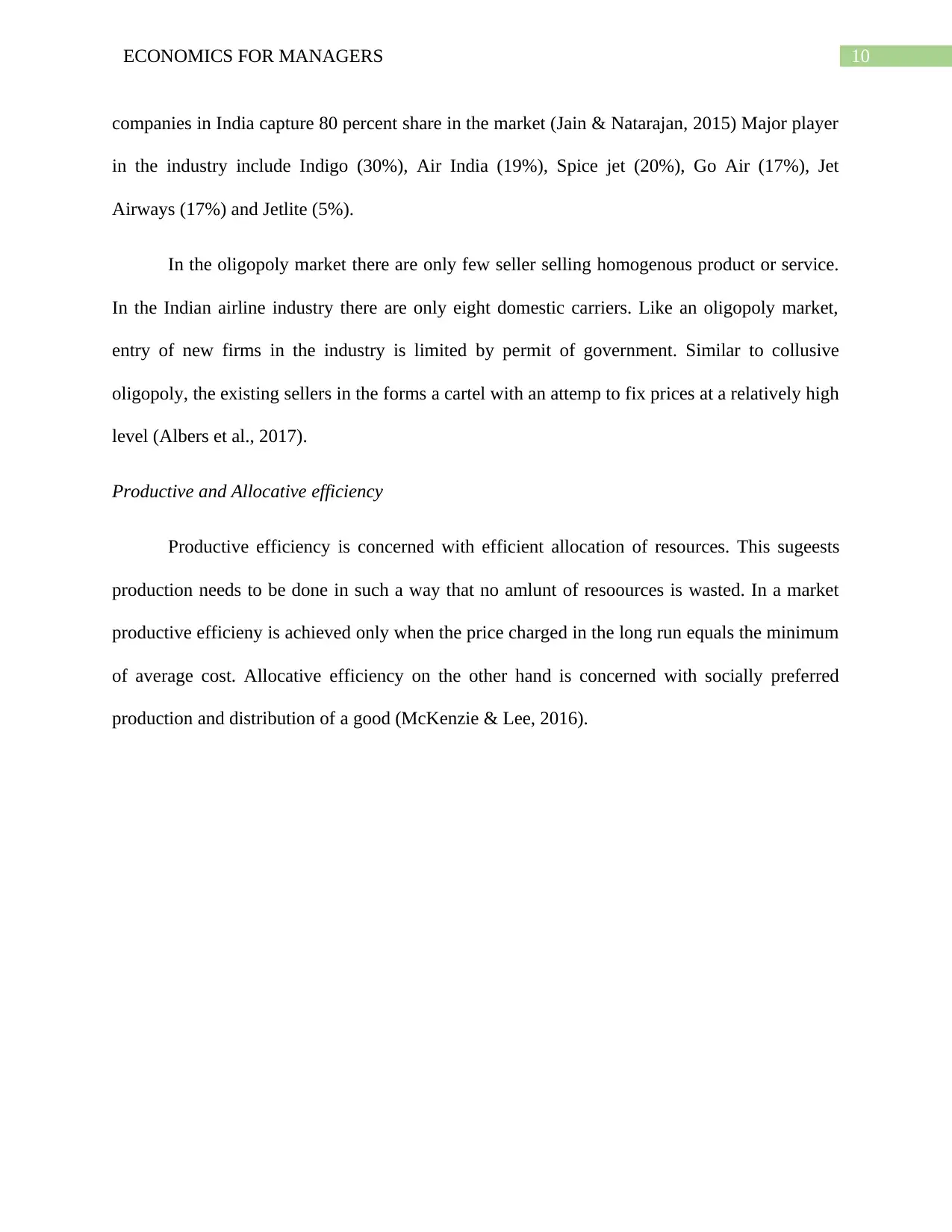
10ECONOMICS FOR MANAGERS
companies in India capture 80 percent share in the market (Jain & Natarajan, 2015) Major player
in the industry include Indigo (30%), Air India (19%), Spice jet (20%), Go Air (17%), Jet
Airways (17%) and Jetlite (5%).
In the oligopoly market there are only few seller selling homogenous product or service.
In the Indian airline industry there are only eight domestic carriers. Like an oligopoly market,
entry of new firms in the industry is limited by permit of government. Similar to collusive
oligopoly, the existing sellers in the forms a cartel with an attemp to fix prices at a relatively high
level (Albers et al., 2017).
Productive and Allocative efficiency
Productive efficiency is concerned with efficient allocation of resources. This sugeests
production needs to be done in such a way that no amlunt of resoources is wasted. In a market
productive efficieny is achieved only when the price charged in the long run equals the minimum
of average cost. Allocative efficiency on the other hand is concerned with socially preferred
production and distribution of a good (McKenzie & Lee, 2016).
companies in India capture 80 percent share in the market (Jain & Natarajan, 2015) Major player
in the industry include Indigo (30%), Air India (19%), Spice jet (20%), Go Air (17%), Jet
Airways (17%) and Jetlite (5%).
In the oligopoly market there are only few seller selling homogenous product or service.
In the Indian airline industry there are only eight domestic carriers. Like an oligopoly market,
entry of new firms in the industry is limited by permit of government. Similar to collusive
oligopoly, the existing sellers in the forms a cartel with an attemp to fix prices at a relatively high
level (Albers et al., 2017).
Productive and Allocative efficiency
Productive efficiency is concerned with efficient allocation of resources. This sugeests
production needs to be done in such a way that no amlunt of resoources is wasted. In a market
productive efficieny is achieved only when the price charged in the long run equals the minimum
of average cost. Allocative efficiency on the other hand is concerned with socially preferred
production and distribution of a good (McKenzie & Lee, 2016).
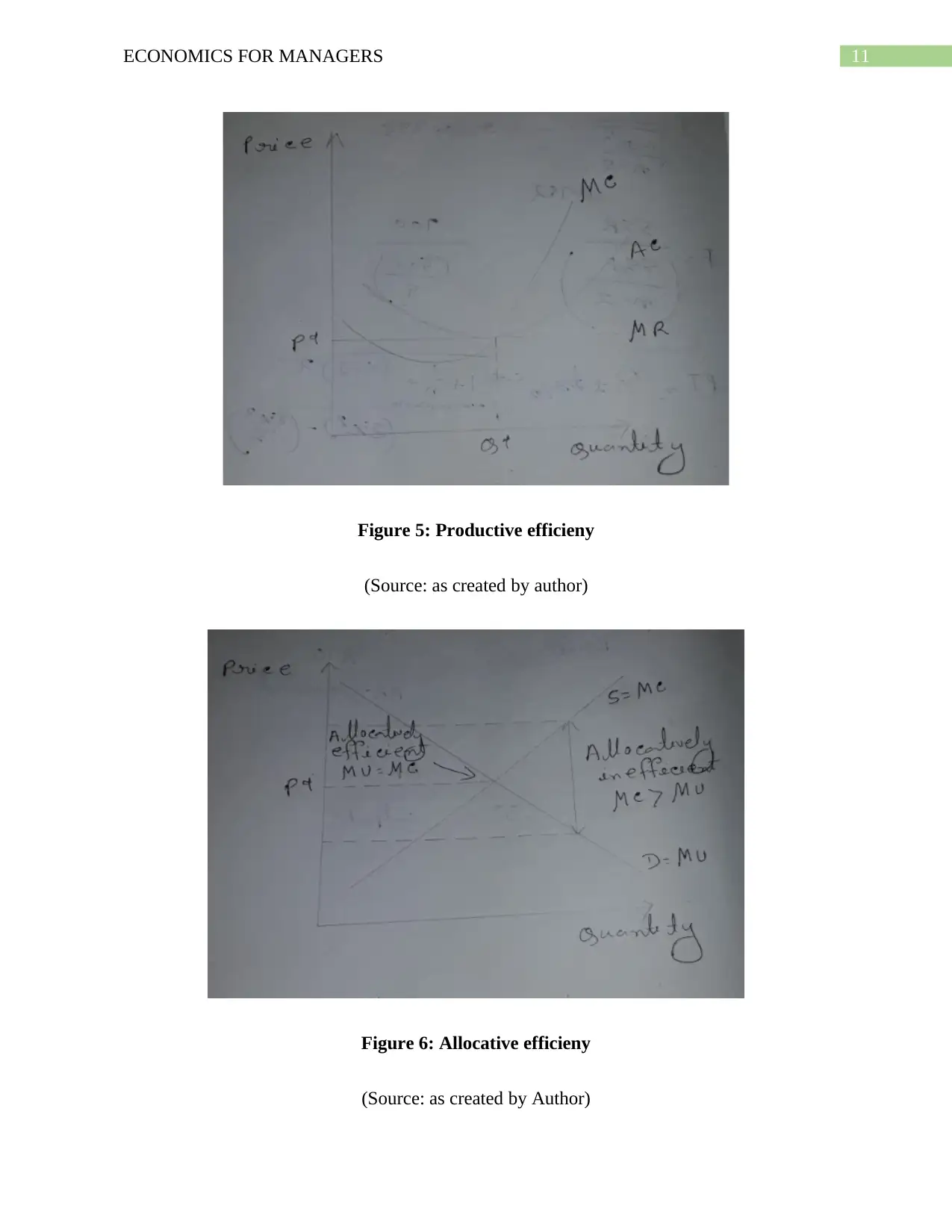
11ECONOMICS FOR MANAGERS
Figure 5: Productive efficieny
(Source: as created by author)
Figure 6: Allocative efficieny
(Source: as created by Author)
Figure 5: Productive efficieny
(Source: as created by author)
Figure 6: Allocative efficieny
(Source: as created by Author)
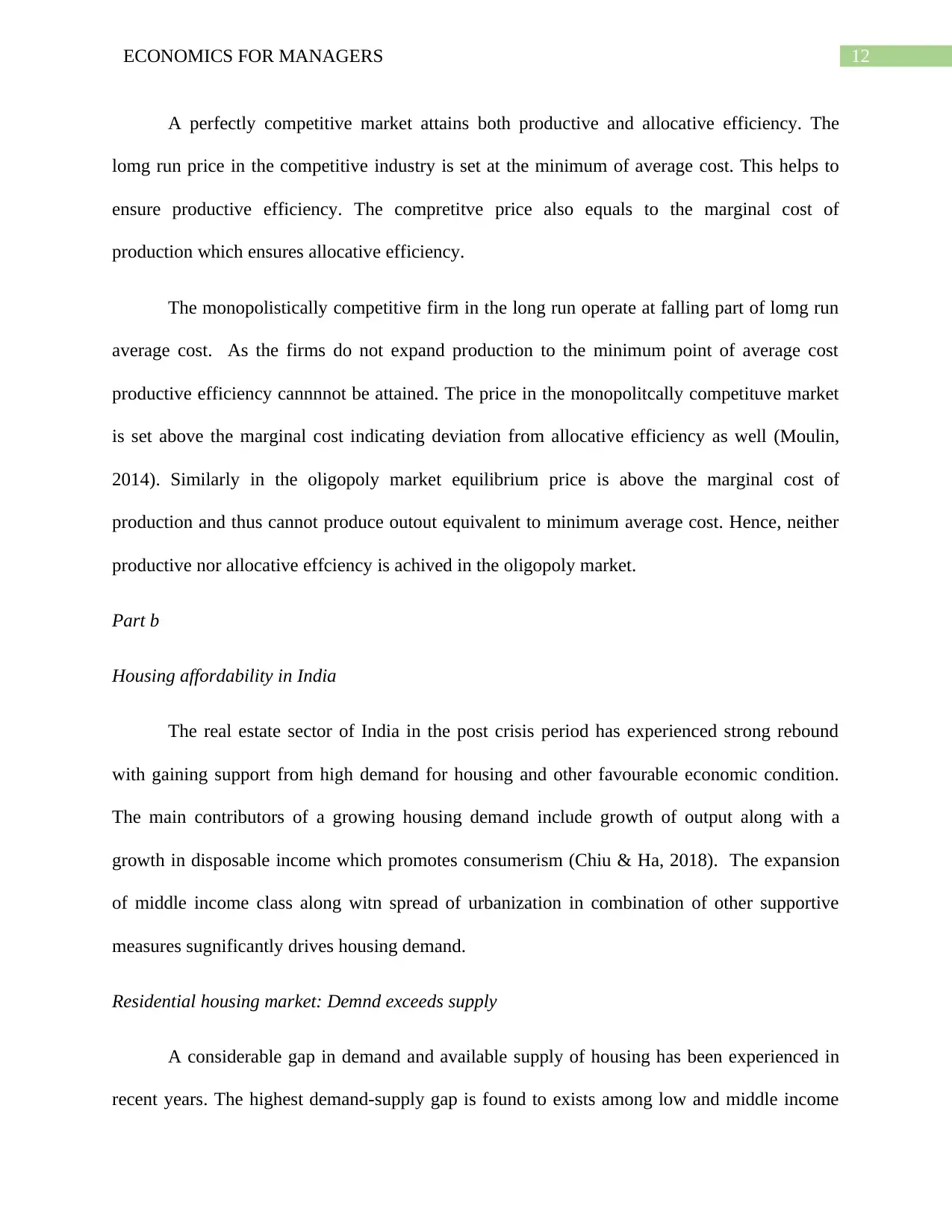
12ECONOMICS FOR MANAGERS
A perfectly competitive market attains both productive and allocative efficiency. The
lomg run price in the competitive industry is set at the minimum of average cost. This helps to
ensure productive efficiency. The compretitve price also equals to the marginal cost of
production which ensures allocative efficiency.
The monopolistically competitive firm in the long run operate at falling part of lomg run
average cost. As the firms do not expand production to the minimum point of average cost
productive efficiency cannnnot be attained. The price in the monopolitcally competituve market
is set above the marginal cost indicating deviation from allocative efficiency as well (Moulin,
2014). Similarly in the oligopoly market equilibrium price is above the marginal cost of
production and thus cannot produce outout equivalent to minimum average cost. Hence, neither
productive nor allocative effciency is achived in the oligopoly market.
Part b
Housing affordability in India
The real estate sector of India in the post crisis period has experienced strong rebound
with gaining support from high demand for housing and other favourable economic condition.
The main contributors of a growing housing demand include growth of output along with a
growth in disposable income which promotes consumerism (Chiu & Ha, 2018). The expansion
of middle income class along witn spread of urbanization in combination of other supportive
measures sugnificantly drives housing demand.
Residential housing market: Demnd exceeds supply
A considerable gap in demand and available supply of housing has been experienced in
recent years. The highest demand-supply gap is found to exists among low and middle income
A perfectly competitive market attains both productive and allocative efficiency. The
lomg run price in the competitive industry is set at the minimum of average cost. This helps to
ensure productive efficiency. The compretitve price also equals to the marginal cost of
production which ensures allocative efficiency.
The monopolistically competitive firm in the long run operate at falling part of lomg run
average cost. As the firms do not expand production to the minimum point of average cost
productive efficiency cannnnot be attained. The price in the monopolitcally competituve market
is set above the marginal cost indicating deviation from allocative efficiency as well (Moulin,
2014). Similarly in the oligopoly market equilibrium price is above the marginal cost of
production and thus cannot produce outout equivalent to minimum average cost. Hence, neither
productive nor allocative effciency is achived in the oligopoly market.
Part b
Housing affordability in India
The real estate sector of India in the post crisis period has experienced strong rebound
with gaining support from high demand for housing and other favourable economic condition.
The main contributors of a growing housing demand include growth of output along with a
growth in disposable income which promotes consumerism (Chiu & Ha, 2018). The expansion
of middle income class along witn spread of urbanization in combination of other supportive
measures sugnificantly drives housing demand.
Residential housing market: Demnd exceeds supply
A considerable gap in demand and available supply of housing has been experienced in
recent years. The highest demand-supply gap is found to exists among low and middle income
Paraphrase This Document
Need a fresh take? Get an instant paraphrase of this document with our AI Paraphraser

13ECONOMICS FOR MANAGERS
segement of housing market. In certain cities of India, housing demand exceeds supply by almost
three to four fold. Demand was forecasted to grow at an annual compund rate of 15% from 2010
to 2014. The cumulative housimg demand stands as 4.25 million units (Gopalan &
Venkataraman, 2015). The National Capital Region and metropolitan cities like Mumbai are
expected to contribute an additional demand of 40%. The forecasted housing demand is highest
for Mumbai (23%) followed by NCR (20%).
A number of factor has been held responsible for growing residential demand for
housing. Of these the most important are rapid spread of urbanization, decline in average size of
household and availability of cheap loans. The impact or urbanization on housimg demand is
most prevalant in cities fall on Tier 1 group. In these cities, housing demand is surged due to
increase in immigrant population proportion (Singla, Chaudhuri & Batchu, 2016). The growth of
average income encourages people to settle in independent house. As the family structure breaks,
the household size gets smller and smaller causing an increase in demand. The socio cultural
shift is one of the important factor givinmg an additional push housing demand.
Figure 7: Analysis of housing demand in different cities
(Source: Tiwari & Rao, 2016).
segement of housing market. In certain cities of India, housing demand exceeds supply by almost
three to four fold. Demand was forecasted to grow at an annual compund rate of 15% from 2010
to 2014. The cumulative housimg demand stands as 4.25 million units (Gopalan &
Venkataraman, 2015). The National Capital Region and metropolitan cities like Mumbai are
expected to contribute an additional demand of 40%. The forecasted housing demand is highest
for Mumbai (23%) followed by NCR (20%).
A number of factor has been held responsible for growing residential demand for
housing. Of these the most important are rapid spread of urbanization, decline in average size of
household and availability of cheap loans. The impact or urbanization on housimg demand is
most prevalant in cities fall on Tier 1 group. In these cities, housing demand is surged due to
increase in immigrant population proportion (Singla, Chaudhuri & Batchu, 2016). The growth of
average income encourages people to settle in independent house. As the family structure breaks,
the household size gets smller and smaller causing an increase in demand. The socio cultural
shift is one of the important factor givinmg an additional push housing demand.
Figure 7: Analysis of housing demand in different cities
(Source: Tiwari & Rao, 2016).
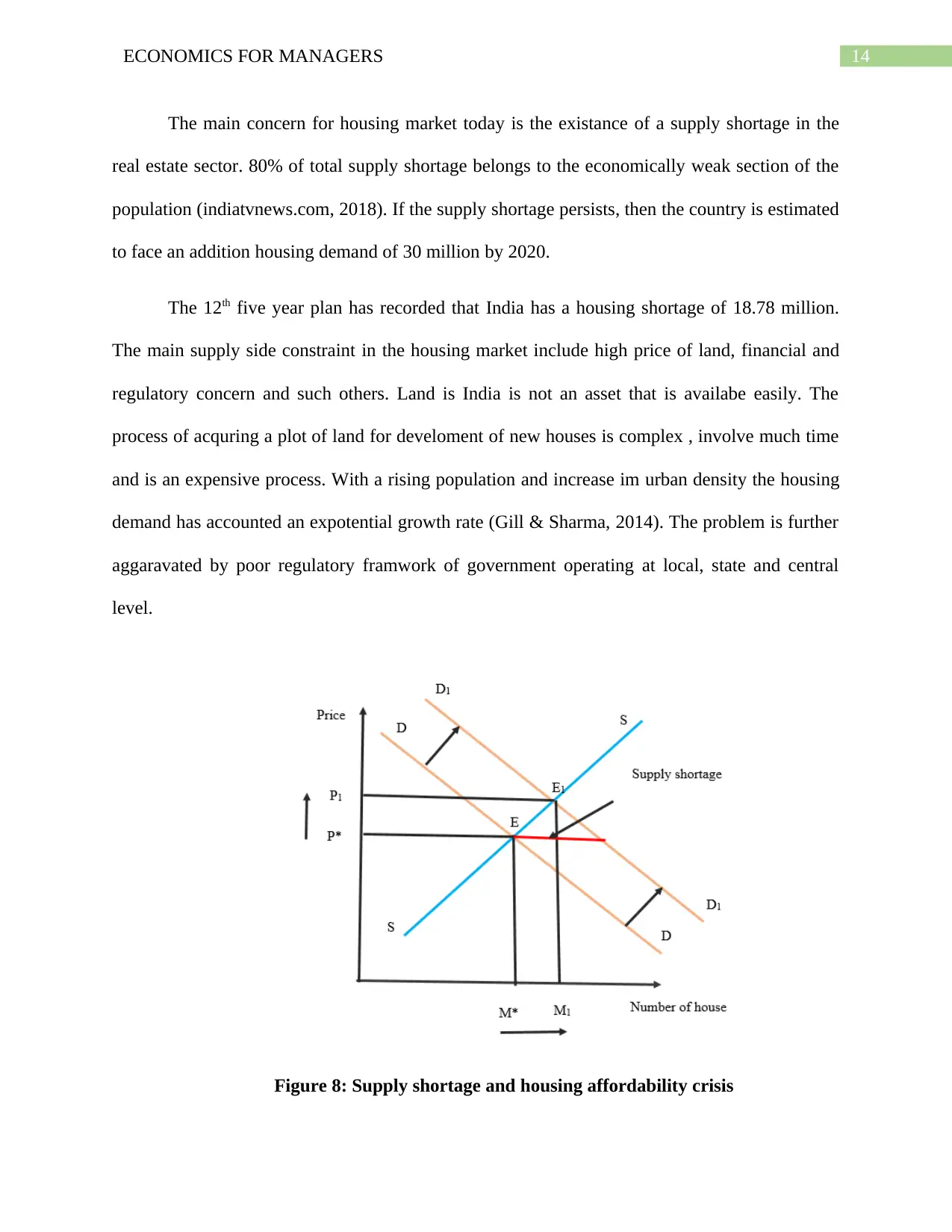
14ECONOMICS FOR MANAGERS
The main concern for housing market today is the existance of a supply shortage in the
real estate sector. 80% of total supply shortage belongs to the economically weak section of the
population (indiatvnews.com, 2018). If the supply shortage persists, then the country is estimated
to face an addition housing demand of 30 million by 2020.
The 12th five year plan has recorded that India has a housing shortage of 18.78 million.
The main supply side constraint in the housing market include high price of land, financial and
regulatory concern and such others. Land is India is not an asset that is availabe easily. The
process of acquring a plot of land for develoment of new houses is complex , involve much time
and is an expensive process. With a rising population and increase im urban density the housing
demand has accounted an expotential growth rate (Gill & Sharma, 2014). The problem is further
aggaravated by poor regulatory framwork of government operating at local, state and central
level.
Figure 8: Supply shortage and housing affordability crisis
The main concern for housing market today is the existance of a supply shortage in the
real estate sector. 80% of total supply shortage belongs to the economically weak section of the
population (indiatvnews.com, 2018). If the supply shortage persists, then the country is estimated
to face an addition housing demand of 30 million by 2020.
The 12th five year plan has recorded that India has a housing shortage of 18.78 million.
The main supply side constraint in the housing market include high price of land, financial and
regulatory concern and such others. Land is India is not an asset that is availabe easily. The
process of acquring a plot of land for develoment of new houses is complex , involve much time
and is an expensive process. With a rising population and increase im urban density the housing
demand has accounted an expotential growth rate (Gill & Sharma, 2014). The problem is further
aggaravated by poor regulatory framwork of government operating at local, state and central
level.
Figure 8: Supply shortage and housing affordability crisis
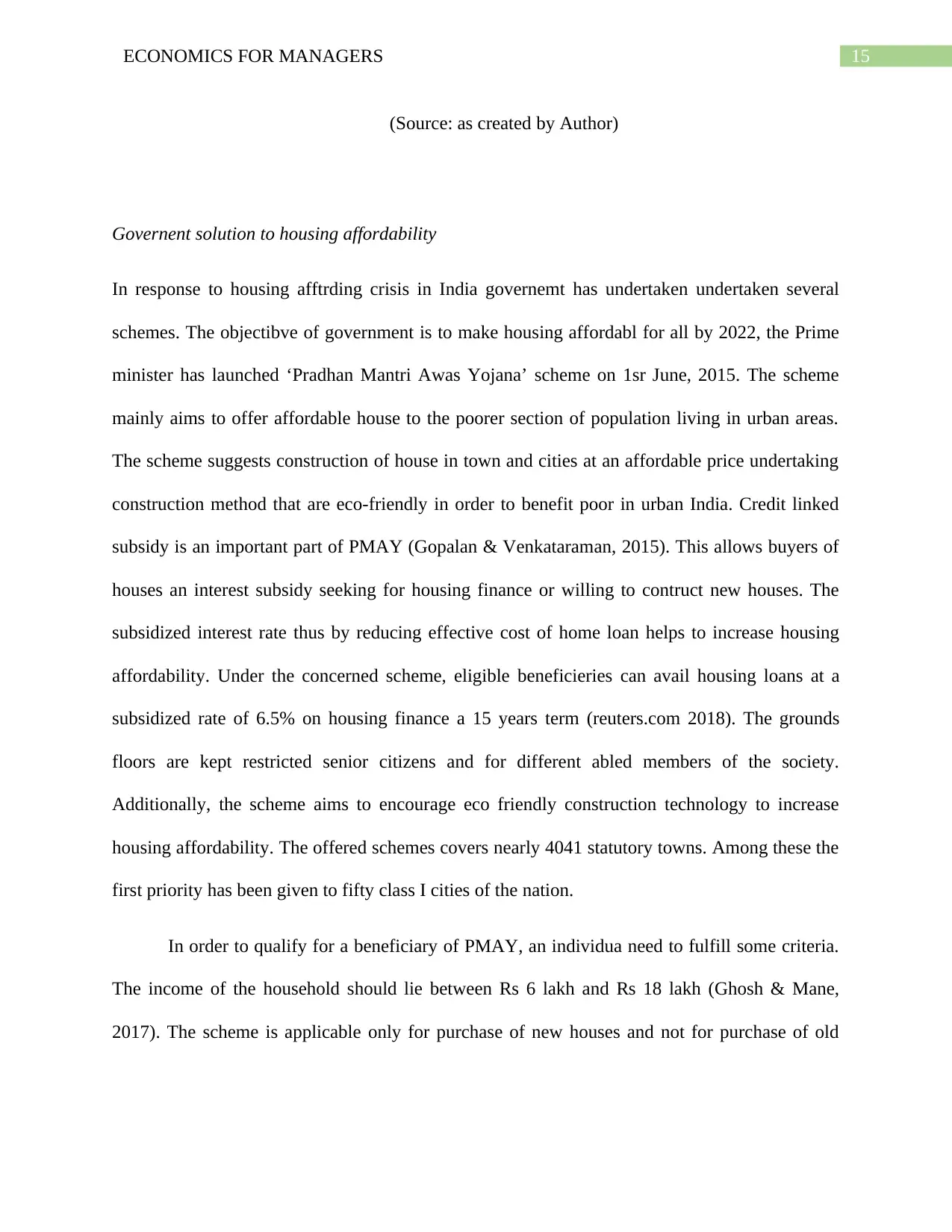
15ECONOMICS FOR MANAGERS
(Source: as created by Author)
Governent solution to housing affordability
In response to housing afftrding crisis in India governemt has undertaken undertaken several
schemes. The objectibve of government is to make housing affordabl for all by 2022, the Prime
minister has launched ‘Pradhan Mantri Awas Yojana’ scheme on 1sr June, 2015. The scheme
mainly aims to offer affordable house to the poorer section of population living in urban areas.
The scheme suggests construction of house in town and cities at an affordable price undertaking
construction method that are eco-friendly in order to benefit poor in urban India. Credit linked
subsidy is an important part of PMAY (Gopalan & Venkataraman, 2015). This allows buyers of
houses an interest subsidy seeking for housing finance or willing to contruct new houses. The
subsidized interest rate thus by reducing effective cost of home loan helps to increase housing
affordability. Under the concerned scheme, eligible beneficieries can avail housing loans at a
subsidized rate of 6.5% on housing finance a 15 years term (reuters.com 2018). The grounds
floors are kept restricted senior citizens and for different abled members of the society.
Additionally, the scheme aims to encourage eco friendly construction technology to increase
housing affordability. The offered schemes covers nearly 4041 statutory towns. Among these the
first priority has been given to fifty class I cities of the nation.
In order to qualify for a beneficiary of PMAY, an individua need to fulfill some criteria.
The income of the household should lie between Rs 6 lakh and Rs 18 lakh (Ghosh & Mane,
2017). The scheme is applicable only for purchase of new houses and not for purchase of old
(Source: as created by Author)
Governent solution to housing affordability
In response to housing afftrding crisis in India governemt has undertaken undertaken several
schemes. The objectibve of government is to make housing affordabl for all by 2022, the Prime
minister has launched ‘Pradhan Mantri Awas Yojana’ scheme on 1sr June, 2015. The scheme
mainly aims to offer affordable house to the poorer section of population living in urban areas.
The scheme suggests construction of house in town and cities at an affordable price undertaking
construction method that are eco-friendly in order to benefit poor in urban India. Credit linked
subsidy is an important part of PMAY (Gopalan & Venkataraman, 2015). This allows buyers of
houses an interest subsidy seeking for housing finance or willing to contruct new houses. The
subsidized interest rate thus by reducing effective cost of home loan helps to increase housing
affordability. Under the concerned scheme, eligible beneficieries can avail housing loans at a
subsidized rate of 6.5% on housing finance a 15 years term (reuters.com 2018). The grounds
floors are kept restricted senior citizens and for different abled members of the society.
Additionally, the scheme aims to encourage eco friendly construction technology to increase
housing affordability. The offered schemes covers nearly 4041 statutory towns. Among these the
first priority has been given to fifty class I cities of the nation.
In order to qualify for a beneficiary of PMAY, an individua need to fulfill some criteria.
The income of the household should lie between Rs 6 lakh and Rs 18 lakh (Ghosh & Mane,
2017). The scheme is applicable only for purchase of new houses and not for purchase of old
Secure Best Marks with AI Grader
Need help grading? Try our AI Grader for instant feedback on your assignments.
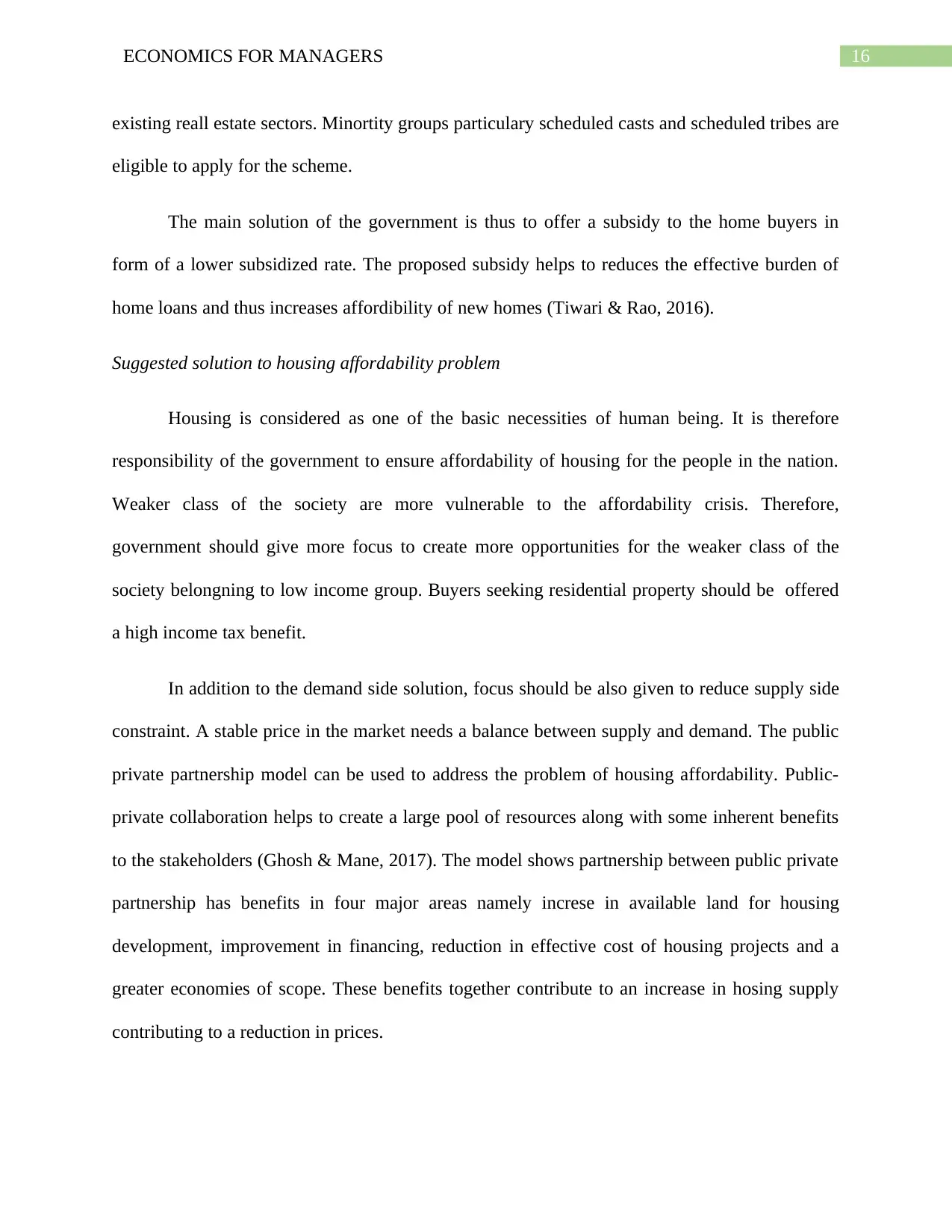
16ECONOMICS FOR MANAGERS
existing reall estate sectors. Minortity groups particulary scheduled casts and scheduled tribes are
eligible to apply for the scheme.
The main solution of the government is thus to offer a subsidy to the home buyers in
form of a lower subsidized rate. The proposed subsidy helps to reduces the effective burden of
home loans and thus increases affordibility of new homes (Tiwari & Rao, 2016).
Suggested solution to housing affordability problem
Housing is considered as one of the basic necessities of human being. It is therefore
responsibility of the government to ensure affordability of housing for the people in the nation.
Weaker class of the society are more vulnerable to the affordability crisis. Therefore,
government should give more focus to create more opportunities for the weaker class of the
society belongning to low income group. Buyers seeking residential property should be offered
a high income tax benefit.
In addition to the demand side solution, focus should be also given to reduce supply side
constraint. A stable price in the market needs a balance between supply and demand. The public
private partnership model can be used to address the problem of housing affordability. Public-
private collaboration helps to create a large pool of resources along with some inherent benefits
to the stakeholders (Ghosh & Mane, 2017). The model shows partnership between public private
partnership has benefits in four major areas namely increse in available land for housing
development, improvement in financing, reduction in effective cost of housing projects and a
greater economies of scope. These benefits together contribute to an increase in hosing supply
contributing to a reduction in prices.
existing reall estate sectors. Minortity groups particulary scheduled casts and scheduled tribes are
eligible to apply for the scheme.
The main solution of the government is thus to offer a subsidy to the home buyers in
form of a lower subsidized rate. The proposed subsidy helps to reduces the effective burden of
home loans and thus increases affordibility of new homes (Tiwari & Rao, 2016).
Suggested solution to housing affordability problem
Housing is considered as one of the basic necessities of human being. It is therefore
responsibility of the government to ensure affordability of housing for the people in the nation.
Weaker class of the society are more vulnerable to the affordability crisis. Therefore,
government should give more focus to create more opportunities for the weaker class of the
society belongning to low income group. Buyers seeking residential property should be offered
a high income tax benefit.
In addition to the demand side solution, focus should be also given to reduce supply side
constraint. A stable price in the market needs a balance between supply and demand. The public
private partnership model can be used to address the problem of housing affordability. Public-
private collaboration helps to create a large pool of resources along with some inherent benefits
to the stakeholders (Ghosh & Mane, 2017). The model shows partnership between public private
partnership has benefits in four major areas namely increse in available land for housing
development, improvement in financing, reduction in effective cost of housing projects and a
greater economies of scope. These benefits together contribute to an increase in hosing supply
contributing to a reduction in prices.
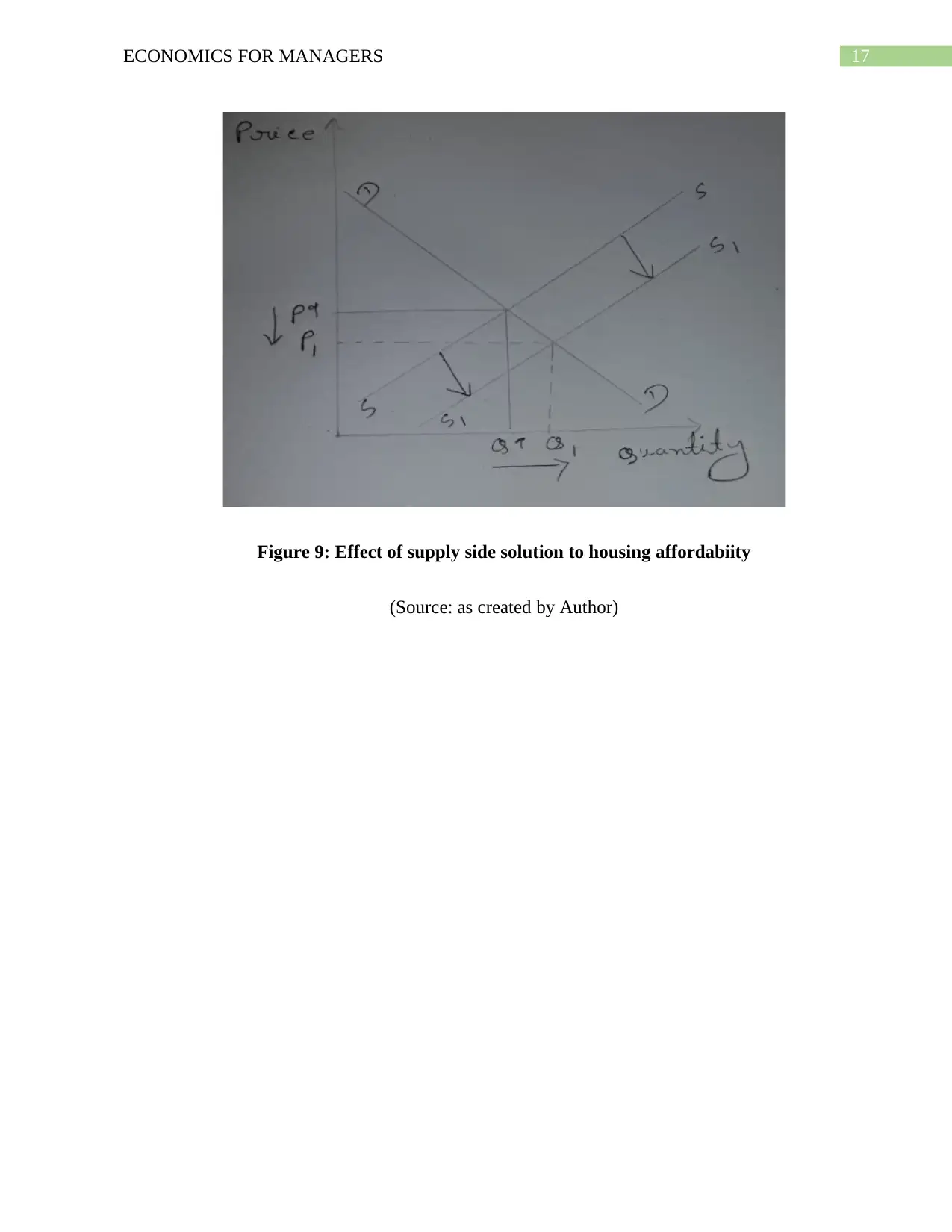
17ECONOMICS FOR MANAGERS
Figure 9: Effect of supply side solution to housing affordabiity
(Source: as created by Author)
Figure 9: Effect of supply side solution to housing affordabiity
(Source: as created by Author)
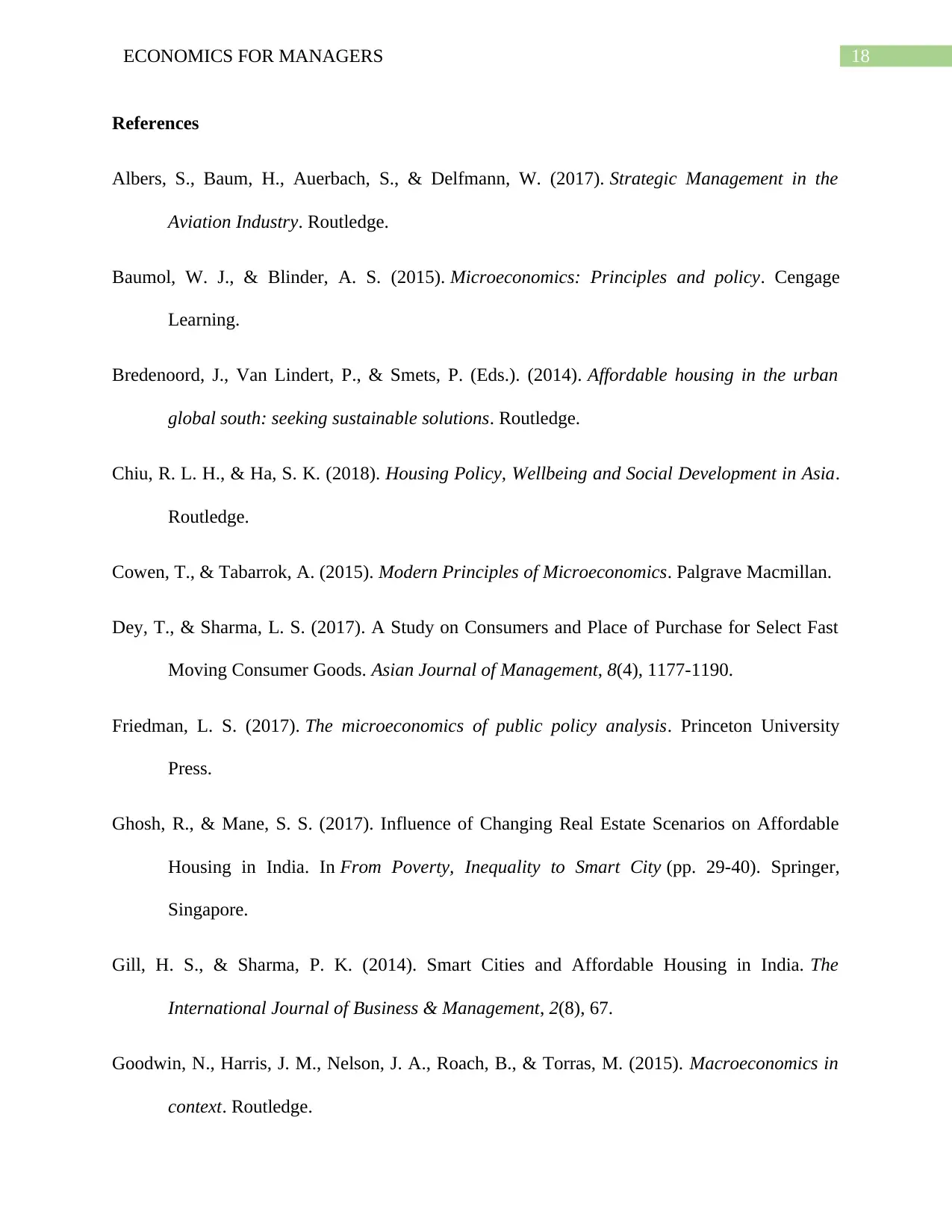
18ECONOMICS FOR MANAGERS
References
Albers, S., Baum, H., Auerbach, S., & Delfmann, W. (2017). Strategic Management in the
Aviation Industry. Routledge.
Baumol, W. J., & Blinder, A. S. (2015). Microeconomics: Principles and policy. Cengage
Learning.
Bredenoord, J., Van Lindert, P., & Smets, P. (Eds.). (2014). Affordable housing in the urban
global south: seeking sustainable solutions. Routledge.
Chiu, R. L. H., & Ha, S. K. (2018). Housing Policy, Wellbeing and Social Development in Asia.
Routledge.
Cowen, T., & Tabarrok, A. (2015). Modern Principles of Microeconomics. Palgrave Macmillan.
Dey, T., & Sharma, L. S. (2017). A Study on Consumers and Place of Purchase for Select Fast
Moving Consumer Goods. Asian Journal of Management, 8(4), 1177-1190.
Friedman, L. S. (2017). The microeconomics of public policy analysis. Princeton University
Press.
Ghosh, R., & Mane, S. S. (2017). Influence of Changing Real Estate Scenarios on Affordable
Housing in India. In From Poverty, Inequality to Smart City (pp. 29-40). Springer,
Singapore.
Gill, H. S., & Sharma, P. K. (2014). Smart Cities and Affordable Housing in India. The
International Journal of Business & Management, 2(8), 67.
Goodwin, N., Harris, J. M., Nelson, J. A., Roach, B., & Torras, M. (2015). Macroeconomics in
context. Routledge.
References
Albers, S., Baum, H., Auerbach, S., & Delfmann, W. (2017). Strategic Management in the
Aviation Industry. Routledge.
Baumol, W. J., & Blinder, A. S. (2015). Microeconomics: Principles and policy. Cengage
Learning.
Bredenoord, J., Van Lindert, P., & Smets, P. (Eds.). (2014). Affordable housing in the urban
global south: seeking sustainable solutions. Routledge.
Chiu, R. L. H., & Ha, S. K. (2018). Housing Policy, Wellbeing and Social Development in Asia.
Routledge.
Cowen, T., & Tabarrok, A. (2015). Modern Principles of Microeconomics. Palgrave Macmillan.
Dey, T., & Sharma, L. S. (2017). A Study on Consumers and Place of Purchase for Select Fast
Moving Consumer Goods. Asian Journal of Management, 8(4), 1177-1190.
Friedman, L. S. (2017). The microeconomics of public policy analysis. Princeton University
Press.
Ghosh, R., & Mane, S. S. (2017). Influence of Changing Real Estate Scenarios on Affordable
Housing in India. In From Poverty, Inequality to Smart City (pp. 29-40). Springer,
Singapore.
Gill, H. S., & Sharma, P. K. (2014). Smart Cities and Affordable Housing in India. The
International Journal of Business & Management, 2(8), 67.
Goodwin, N., Harris, J. M., Nelson, J. A., Roach, B., & Torras, M. (2015). Macroeconomics in
context. Routledge.
Paraphrase This Document
Need a fresh take? Get an instant paraphrase of this document with our AI Paraphraser
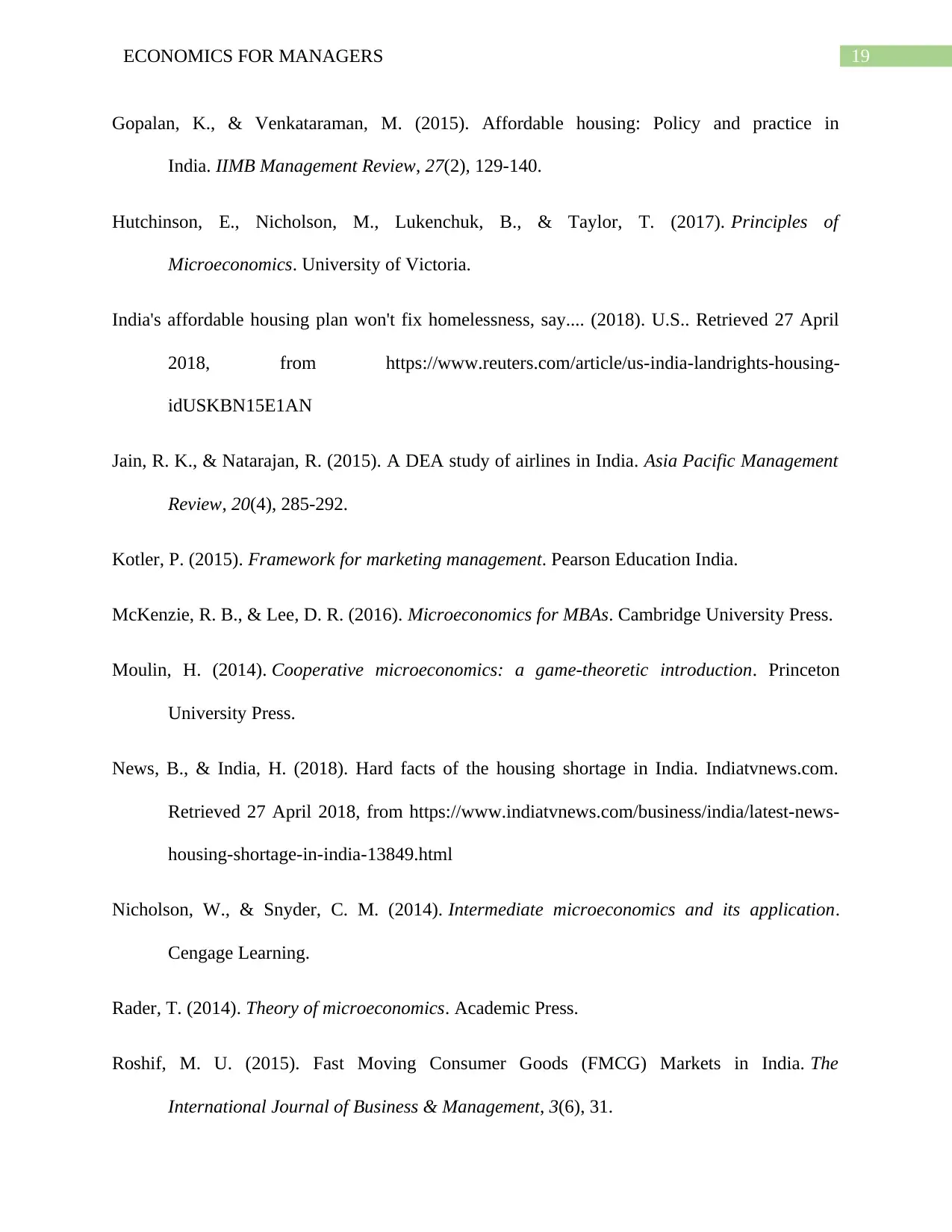
19ECONOMICS FOR MANAGERS
Gopalan, K., & Venkataraman, M. (2015). Affordable housing: Policy and practice in
India. IIMB Management Review, 27(2), 129-140.
Hutchinson, E., Nicholson, M., Lukenchuk, B., & Taylor, T. (2017). Principles of
Microeconomics. University of Victoria.
India's affordable housing plan won't fix homelessness, say.... (2018). U.S.. Retrieved 27 April
2018, from https://www.reuters.com/article/us-india-landrights-housing-
idUSKBN15E1AN
Jain, R. K., & Natarajan, R. (2015). A DEA study of airlines in India. Asia Pacific Management
Review, 20(4), 285-292.
Kotler, P. (2015). Framework for marketing management. Pearson Education India.
McKenzie, R. B., & Lee, D. R. (2016). Microeconomics for MBAs. Cambridge University Press.
Moulin, H. (2014). Cooperative microeconomics: a game-theoretic introduction. Princeton
University Press.
News, B., & India, H. (2018). Hard facts of the housing shortage in India. Indiatvnews.com.
Retrieved 27 April 2018, from https://www.indiatvnews.com/business/india/latest-news-
housing-shortage-in-india-13849.html
Nicholson, W., & Snyder, C. M. (2014). Intermediate microeconomics and its application.
Cengage Learning.
Rader, T. (2014). Theory of microeconomics. Academic Press.
Roshif, M. U. (2015). Fast Moving Consumer Goods (FMCG) Markets in India. The
International Journal of Business & Management, 3(6), 31.
Gopalan, K., & Venkataraman, M. (2015). Affordable housing: Policy and practice in
India. IIMB Management Review, 27(2), 129-140.
Hutchinson, E., Nicholson, M., Lukenchuk, B., & Taylor, T. (2017). Principles of
Microeconomics. University of Victoria.
India's affordable housing plan won't fix homelessness, say.... (2018). U.S.. Retrieved 27 April
2018, from https://www.reuters.com/article/us-india-landrights-housing-
idUSKBN15E1AN
Jain, R. K., & Natarajan, R. (2015). A DEA study of airlines in India. Asia Pacific Management
Review, 20(4), 285-292.
Kotler, P. (2015). Framework for marketing management. Pearson Education India.
McKenzie, R. B., & Lee, D. R. (2016). Microeconomics for MBAs. Cambridge University Press.
Moulin, H. (2014). Cooperative microeconomics: a game-theoretic introduction. Princeton
University Press.
News, B., & India, H. (2018). Hard facts of the housing shortage in India. Indiatvnews.com.
Retrieved 27 April 2018, from https://www.indiatvnews.com/business/india/latest-news-
housing-shortage-in-india-13849.html
Nicholson, W., & Snyder, C. M. (2014). Intermediate microeconomics and its application.
Cengage Learning.
Rader, T. (2014). Theory of microeconomics. Academic Press.
Roshif, M. U. (2015). Fast Moving Consumer Goods (FMCG) Markets in India. The
International Journal of Business & Management, 3(6), 31.
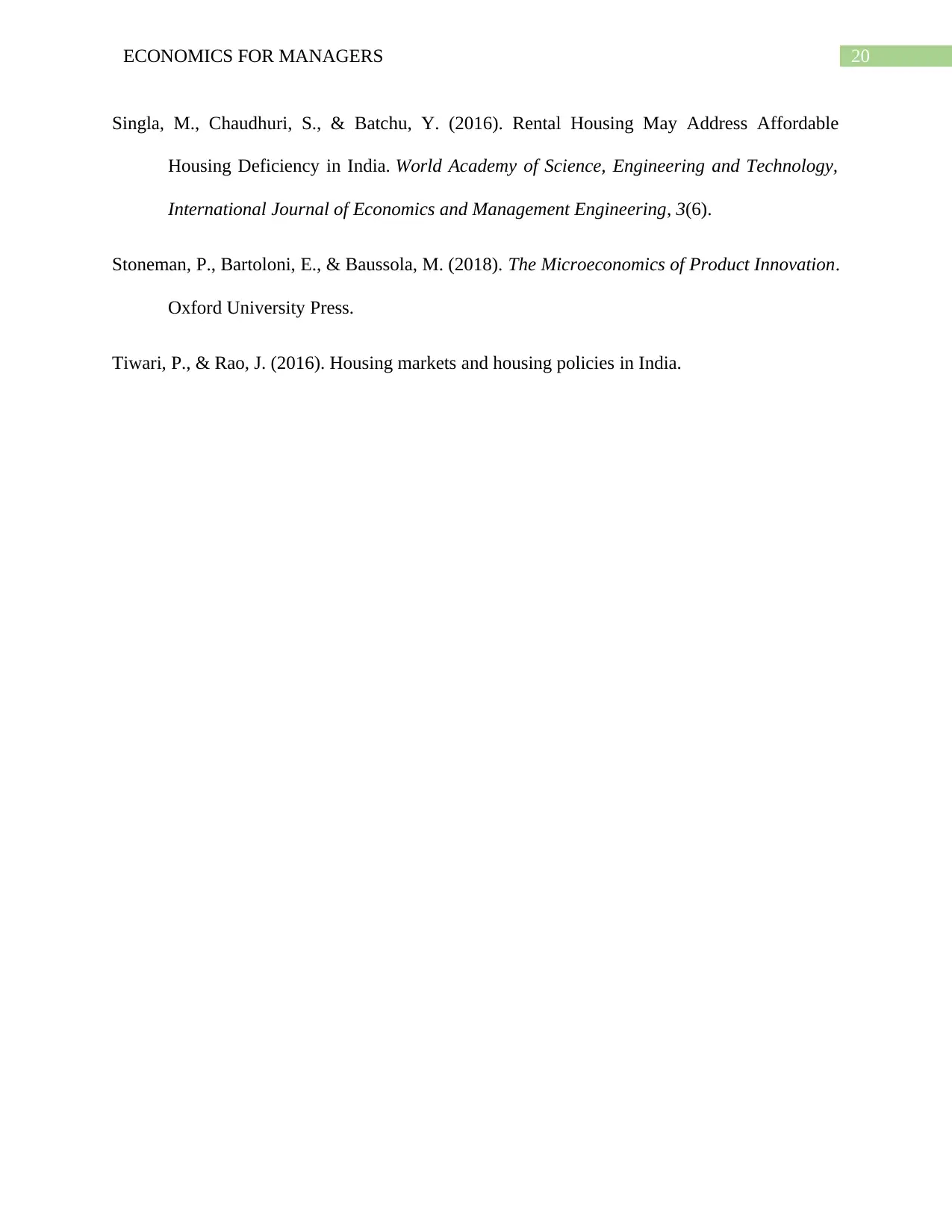
20ECONOMICS FOR MANAGERS
Singla, M., Chaudhuri, S., & Batchu, Y. (2016). Rental Housing May Address Affordable
Housing Deficiency in India. World Academy of Science, Engineering and Technology,
International Journal of Economics and Management Engineering, 3(6).
Stoneman, P., Bartoloni, E., & Baussola, M. (2018). The Microeconomics of Product Innovation.
Oxford University Press.
Tiwari, P., & Rao, J. (2016). Housing markets and housing policies in India.
Singla, M., Chaudhuri, S., & Batchu, Y. (2016). Rental Housing May Address Affordable
Housing Deficiency in India. World Academy of Science, Engineering and Technology,
International Journal of Economics and Management Engineering, 3(6).
Stoneman, P., Bartoloni, E., & Baussola, M. (2018). The Microeconomics of Product Innovation.
Oxford University Press.
Tiwari, P., & Rao, J. (2016). Housing markets and housing policies in India.
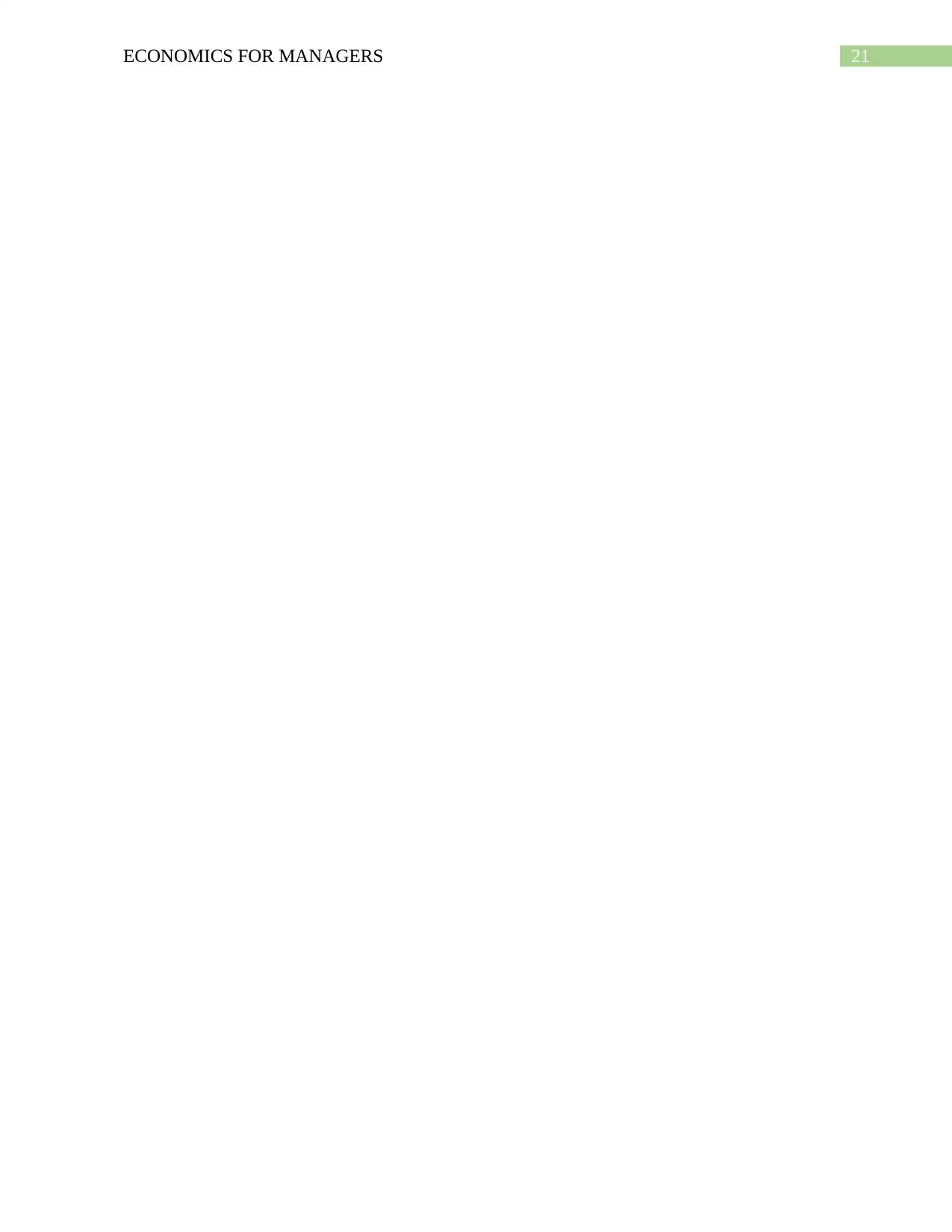
21ECONOMICS FOR MANAGERS
Secure Best Marks with AI Grader
Need help grading? Try our AI Grader for instant feedback on your assignments.
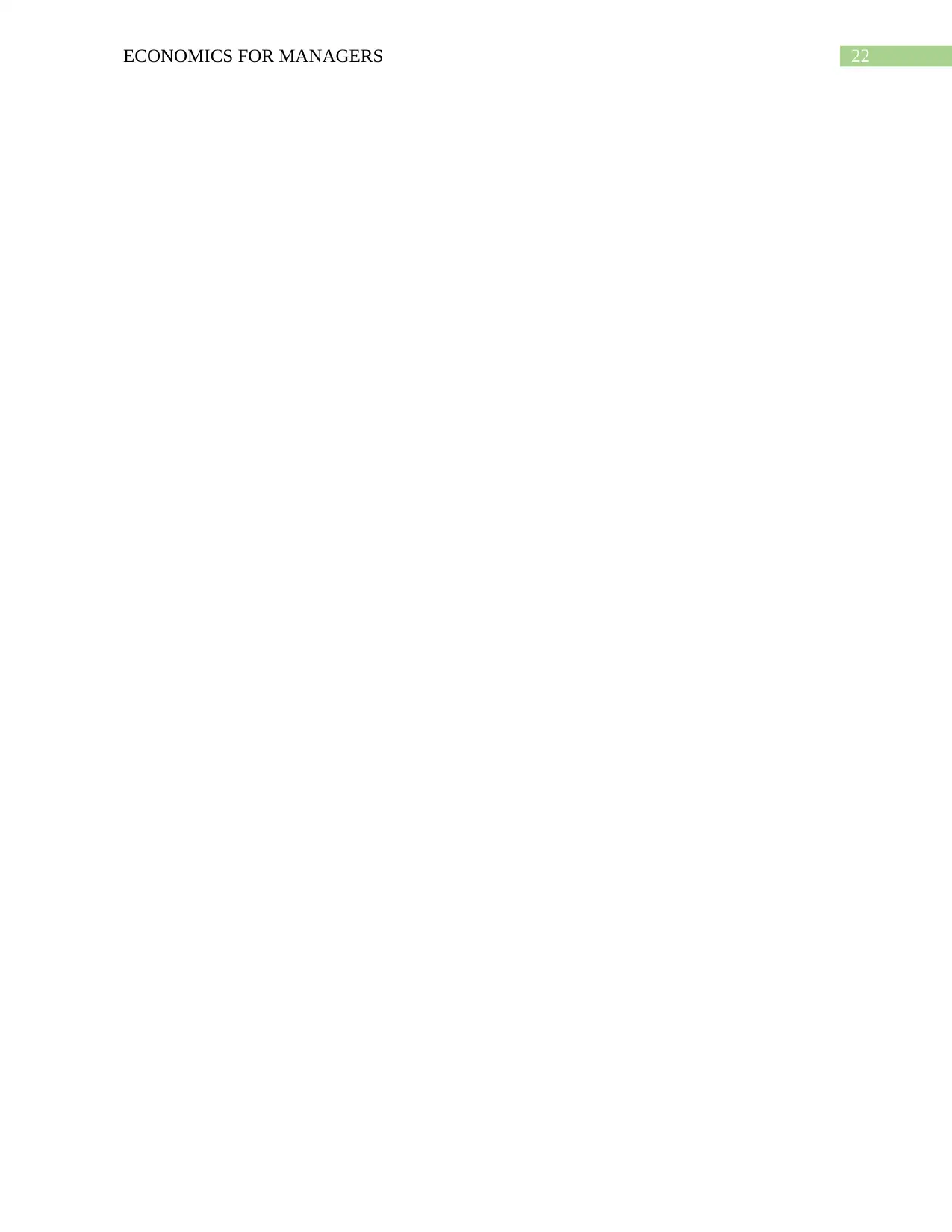
22ECONOMICS FOR MANAGERS
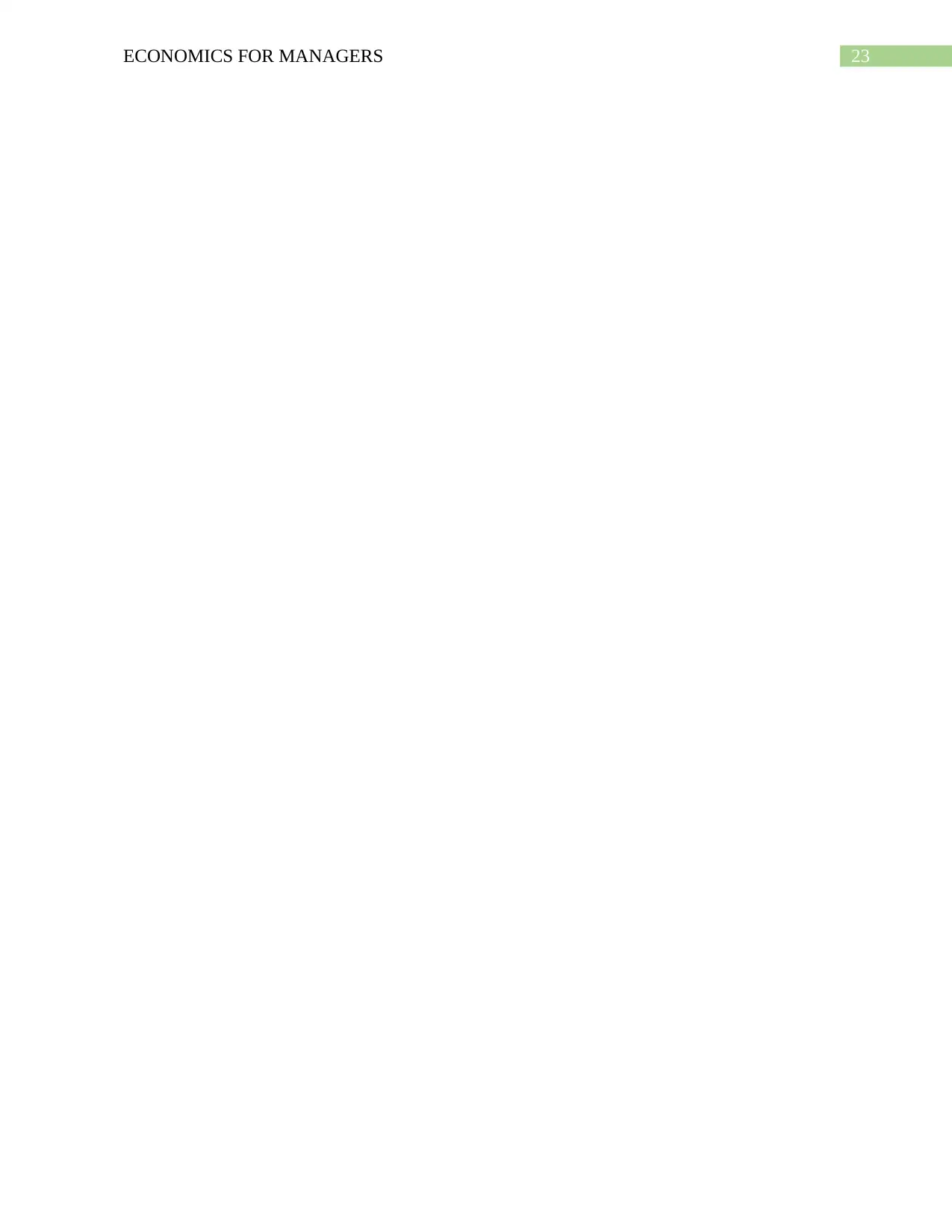
23ECONOMICS FOR MANAGERS
1 out of 24
Related Documents
Your All-in-One AI-Powered Toolkit for Academic Success.
+13062052269
info@desklib.com
Available 24*7 on WhatsApp / Email
![[object Object]](/_next/static/media/star-bottom.7253800d.svg)
Unlock your academic potential
© 2024 | Zucol Services PVT LTD | All rights reserved.




